
7 Field Company RE War Diary 1914
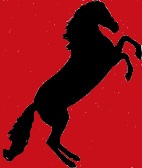
4th Division TRF WW1
The order of battle of the 4th Division 1914-15 (at the time 7 Coy served in the 4th Division)
10th Brigade
1st Bn, the Royal Warwickshire Regt
1st Bn, the Royal Irish Fusiliers
2nd Bn, the Royal Dublin Fusiliers
1/7th, the Argyle and Sutherland Highlanders - Joined January 1915
11th Brigade
1st Bn, the Somerset Light Infantry
1st Bn, East Lancashire Regt
1st Bn, the Hampshire Regt
1st Bn, the Rifle Brigade
1/5 Bn, the London Regt LRB - Joined November 1914 - left May 1915
12th Brigade
1st Bn, the Essex Regiment
1st Bn, the King’s Own (Lancaster)
2nd Bn, the Lancashire Fusiliers
2nd Bn, the Royal Inniskilling Fusiliers - left December 1914
Divisional Mounted Troops
B Squadron, the 19th Hussars - Left April 1915
A Sqn, the 1/st Northamptonshire Yeomanry - Joined April 1915
4th Company, Army Cyclist Corps
Divisional Artillery
XIV Brigade, RFA
XXIX Brigade, RFA
XXXII Brigade, RFA
XXXVII (Howitzer) Brigade, RFA - left February 1915
CXXVII (Howitzer) Brigade
Royal Engineers
7th Field Company
9th Field Company
1st (West Lancashire) Field Company - joined February 1915, left February 1916
Royal Army Medical Corps
10th Field Ambulance
11th Field Ambulance
12th Field Ambulance
10th Brigade
1st Bn, the Royal Warwickshire Regt
1st Bn, the Royal Irish Fusiliers
2nd Bn, the Royal Dublin Fusiliers
1/7th, the Argyle and Sutherland Highlanders - Joined January 1915
11th Brigade
1st Bn, the Somerset Light Infantry
1st Bn, East Lancashire Regt
1st Bn, the Hampshire Regt
1st Bn, the Rifle Brigade
1/5 Bn, the London Regt LRB - Joined November 1914 - left May 1915
12th Brigade
1st Bn, the Essex Regiment
1st Bn, the King’s Own (Lancaster)
2nd Bn, the Lancashire Fusiliers
2nd Bn, the Royal Inniskilling Fusiliers - left December 1914
Divisional Mounted Troops
B Squadron, the 19th Hussars - Left April 1915
A Sqn, the 1/st Northamptonshire Yeomanry - Joined April 1915
4th Company, Army Cyclist Corps
Divisional Artillery
XIV Brigade, RFA
XXIX Brigade, RFA
XXXII Brigade, RFA
XXXVII (Howitzer) Brigade, RFA - left February 1915
CXXVII (Howitzer) Brigade
Royal Engineers
7th Field Company
9th Field Company
1st (West Lancashire) Field Company - joined February 1915, left February 1916
Royal Army Medical Corps
10th Field Ambulance
11th Field Ambulance
12th Field Ambulance
In 1914, 7 Field Company served in the 4th Division until April 1915 when it moved into the 48th Division for a short period. In June 1915 the Company moved into the 50th Division where it remained until the end of the war.
King George V cap badge
The Roman Numeral V is between the G & R on the Royal Cypher
The Roman Numeral V is between the G & R on the Royal Cypher
The above cap badge was made for economical reasons during 1916 and darkened to reduce glare
The above badge was solid for economical and mass production purposes
7 Field Company War Diary 1914
Source:
7 Field Company War Diary 1914:
Personal Diary of Pioneer J. E. Daniels, 7 Field Company
August 1914 to April 1915. (below)
7 Field Company War Diary 1914:
Personal Diary of Pioneer J. E. Daniels, 7 Field Company
August 1914 to April 1915. (below)
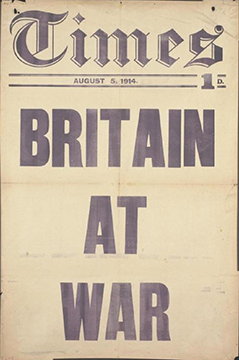
7 Field Company War Diary 1914
.
O.C. Major S.G. Faber with NCOs of 7 Field Company 1914
August 1914
5 Aug First day of mobilization
6-9 Aug. Mobilization proceeded normally except for horses required to complete, which could not be obtained until the 8th and the following day
10-18 Aug. Company did Route Marches, Pontooning, etc
18 Aug. Entrained at Shorncliffe at 10.35pm
5 Aug First day of mobilization
6-9 Aug. Mobilization proceeded normally except for horses required to complete, which could not be obtained until the 8th and the following day
10-18 Aug. Company did Route Marches, Pontooning, etc
18 Aug. Entrained at Shorncliffe at 10.35pm
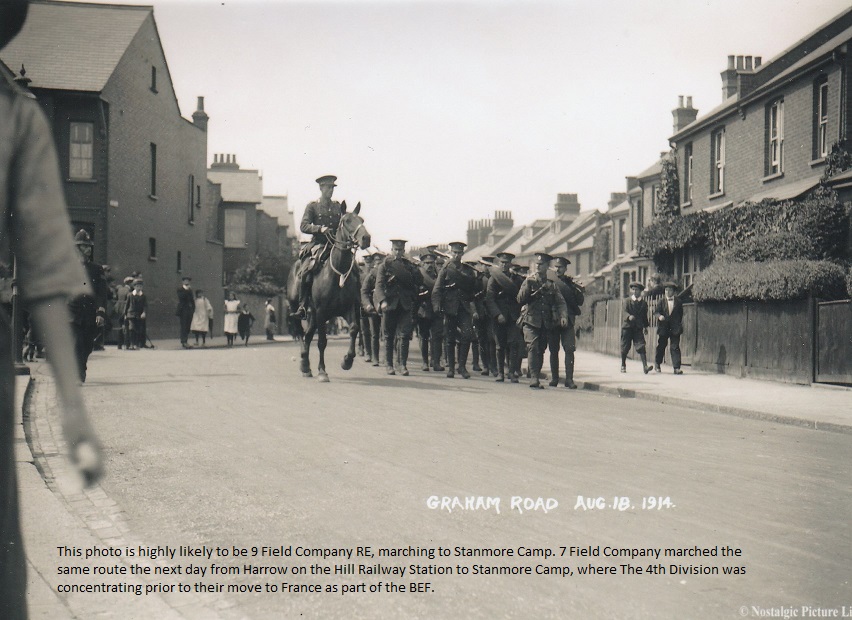
30 Aug. Bridges ready for demolition. Company (less demolition parties) marched 5am with 10 Bde. (orders for demolition attached)
During the demolition of the last bridge, a stone one over the river, Lt Gourlay and party were fired on by Uhlans When at first they were on the far bank but subsequently crossed into Sempigny. The 9th Lancers were providing the covering party but did not detect the approaches of the enemy. The demolition party escaped on bikes and on 9th Lancer's horses but two men were found missing. (believed dead as they were wounded) Sappers 11760 Coleman J and 10519 Butler J.
A tool cart bolted and was lost. Company bivouacked at Cuise Lamotte about 11pm. The first bridge is blown at 3.30.am. All cyclists are sent to blow up barges in the canal
31Aug. Company marched to Verbere. Start at 8.30.am. Marched ten miles, stopped for a meal then continued marching for about another 15 miles through the forest of Compeigne. Finished march at 9.30pm. Marching in a long column with numerous lengthy delays. Company bivouacked in an onion field
During the demolition of the last bridge, a stone one over the river, Lt Gourlay and party were fired on by Uhlans When at first they were on the far bank but subsequently crossed into Sempigny. The 9th Lancers were providing the covering party but did not detect the approaches of the enemy. The demolition party escaped on bikes and on 9th Lancer's horses but two men were found missing. (believed dead as they were wounded) Sappers 11760 Coleman J and 10519 Butler J.
A tool cart bolted and was lost. Company bivouacked at Cuise Lamotte about 11pm. The first bridge is blown at 3.30.am. All cyclists are sent to blow up barges in the canal
31Aug. Company marched to Verbere. Start at 8.30.am. Marched ten miles, stopped for a meal then continued marching for about another 15 miles through the forest of Compeigne. Finished march at 9.30pm. Marching in a long column with numerous lengthy delays. Company bivouacked in an onion field
19 Aug. Reached Harrow on the Hill,detrained by 5am and marched to Stanmore Camp
20 Aug. Route Marches, erecting structures for 10 Bde
21 Aug. Entrained and left Harrow on the Hill Station at 10.25pm
22 Aug. Arrived Southampton at 2.15am. Embarked SS Algerian and sailed at 8.am. HQRE 4 DIV and HQ and 1 Section of Signal Company also onboard. Left England with full compliment of men but short of two horses owing to sickness enroute.The passage across was smooth. Arrived at Havre at 6.pm. Anchored off Havre lighthouse for the night.
23 Aug. Underway at 8.am sailed up the River Seine. The trip up the river was beautiful as regards weather and scenery. People cheered all the way up the river firing small guns, fireworks and singing 'Vive L'Angleterre'. They were answered with shouts of 'are we down hearted?' The Company arrived at Rouen at 4pm. The docks were crowded with people who besieged the men for souvenirs. Disembarkation completed at 11.30pm. Marched 4 miles to Bruyeres Camp, which was close to the race course.
24 Aug. In camp preparing equipment
25 Aug. Reveille at 1.30am. Marched 6 miles to Dametal. A hot day. While waiting for the train, several trains passed through carrying wounded and refugees from Mons. Departed Dametal 8.30.pm.
20 Aug. Route Marches, erecting structures for 10 Bde
21 Aug. Entrained and left Harrow on the Hill Station at 10.25pm
22 Aug. Arrived Southampton at 2.15am. Embarked SS Algerian and sailed at 8.am. HQRE 4 DIV and HQ and 1 Section of Signal Company also onboard. Left England with full compliment of men but short of two horses owing to sickness enroute.The passage across was smooth. Arrived at Havre at 6.pm. Anchored off Havre lighthouse for the night.
23 Aug. Underway at 8.am sailed up the River Seine. The trip up the river was beautiful as regards weather and scenery. People cheered all the way up the river firing small guns, fireworks and singing 'Vive L'Angleterre'. They were answered with shouts of 'are we down hearted?' The Company arrived at Rouen at 4pm. The docks were crowded with people who besieged the men for souvenirs. Disembarkation completed at 11.30pm. Marched 4 miles to Bruyeres Camp, which was close to the race course.
24 Aug. In camp preparing equipment
25 Aug. Reveille at 1.30am. Marched 6 miles to Dametal. A hot day. While waiting for the train, several trains passed through carrying wounded and refugees from Mons. Departed Dametal 8.30.pm.
Whilst at the camp the Company witnessed our infantry returning, never more than a hundred per party. They were absolutely dead beat, boots worn out, unshaven and dirty. The officers were in the same state.Each contingent returning would make for the riding school, flop down and immediately fall asleep.
26 Aug. Arrived at St. Quentin at 8.am. In sidings until 3.45pm.Trained back to Noyon arriving 6pm. In sidings all night.Two men missing on leaving St. Quentin. Many men made themselves ill eating apples. Stayed in the sidings and slept in the railway carriages in an uncomfortable bed
27 Aug. Detrained (men,equipment and carts) and marched to Cavalry Barracks arriving 11am. Major Faber, Lts' Wright and Gourlay and seven NCOs went to Ham to assist with preparations of a defensive position. They rejoined during the night except for 3 NCOs.
27 Aug. Detrained (men,equipment and carts) and marched to Cavalry Barracks arriving 11am. Major Faber, Lts' Wright and Gourlay and seven NCOs went to Ham to assist with preparations of a defensive position. They rejoined during the night except for 3 NCOs.
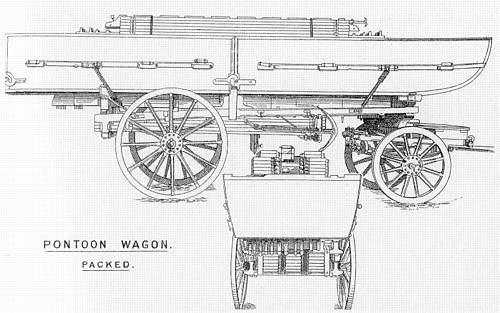
28 Aug. Two Pontoon wagons plus one Trestle wagon left at 8.30am for Compiegne to join bridging wagons of other companies there.
Lt Macready and a party of 3 made a reconnaissance of bridges near Sempigny, Varesnes etc for demolition .
Company marched at 3.30pm to Sempigny to join HQ DIV Engineers, 4 Signal Co RE and 9th Field Company RE there.
3 NCOs joined from Ham. 1 man missing on leaving Noyon
29 Aug. Orders received through CRE about midday to prepare 3 bridges (2 over canals and 1 over River Oise) between Pont D' Eveque and Sempigny for demolition. Work continues through the night. Reveille at 5am. Men take a bath in the canal. Arms inspection at 9.30am. Troops are passing through all day. News comes in that a Major in 9th Company has been killed. A French plane brIngs down a German plane after a short struggle.
Lt Macready and a party of 3 made a reconnaissance of bridges near Sempigny, Varesnes etc for demolition .
Company marched at 3.30pm to Sempigny to join HQ DIV Engineers, 4 Signal Co RE and 9th Field Company RE there.
3 NCOs joined from Ham. 1 man missing on leaving Noyon
29 Aug. Orders received through CRE about midday to prepare 3 bridges (2 over canals and 1 over River Oise) between Pont D' Eveque and Sempigny for demolition. Work continues through the night. Reveille at 5am. Men take a bath in the canal. Arms inspection at 9.30am. Troops are passing through all day. News comes in that a Major in 9th Company has been killed. A French plane brIngs down a German plane after a short struggle.
The Diary of Pioneer J.E. Daniels is written in blue text
September 1914
1 Sep. Company reveille at 4.30.am by shots from neighbouring gardens. The company were surprised by Uhlans. The sentry shot and wounded a Uhlan of two were seen. The Company had been informed the previous evening by the OC the 11th Brigade ..... In which it was said no special protective measures were necessary. There were surprises and heavy casualties amongst other troops in the 4th Division. The Company formed up and marched with 12th Brigade transport to Chamicy and found a large farm and went into state of defence. Left there at 2.30.pm and marched to Montpilly to put that village in state of defence. Orders cancelled soon after work began. Company marched to Barom and bivouacked.
2 Sep. Company marched 12.30.am to Dammartin, arriving at 7.30.am. Improved water supply and rested. Left Dammartin 11.30.pm. We march all night until 7.30am bivouacking at Dammartin about 50 miles from Paris.
3 Sep. Arrived and bivouac at Chanteloup 3 miles S of Lagny at 2.pm. After a trying march, Major Faber RE moved to 7 Field Ambulance sick. Capt I P Smith took over command.We continue in column, the cyclists in advance to fill in small trenches and obstacles the refugees had put up. We arrive at Claye at 6.am and march on to Lagny where we arrive at 9.30.am. We bivouac about 5 miles further on at a village called Chantelope
4 Sep. Remained and rested at Chanteloup till 2.30.pm. No 3 Section, Lt Gourlay then joined DIV HQ at Jossigny. Company marched to Coupvray with 11 Bde and bivouacked in the grounds of the Chateau. Roused at 11.30pm and marched towards Jossigny as the enemy were now in gun range of the Chateau.
Saturday 5 Sep. The Company pass through Pontcarre at 6.30.am and on through Chevy arriving at Brie about midday. The Company had marched 32 miles from their starting point. It was their stiffest march in boiling hot weather. The Company bivouacked 2 miles outside Brie.
Sunday 6 Sep. Marched at 4.am to near Jossigny. The Company rested for a few hours with the 11th Inf Bde, then marched to and bivouacked at Villeneuve Le Aqiate ? in the 11 Inf Bde area. During this and the following days 11th Bde was acting as reserve to 4th Division, which in turn was in support of the 1st Army directly engaged with the enemy to the East.
We leave bivouac at 3.30.am and commence to advance. We hear the guns of the French and Germans. We have an hour's rest and proceed again at 2.30.pm passing through Ferriers and Josigny. We arrive at our bivouac at 6.30.pm at Hilleneuve.
7 Sep. Marched at 11.15.am arrived at 7.pm and bivouacked at Maisoncelles. German troops had only just quitted the neighbourhood. Our infantry open fire at daybreak, we advance at 10.15.am passing through Creacy, a beautifully situated village. We bivouac at 7.30.pm at Maisoncelles which is 40 mile east of Paris.
8 Sep. Left Maisoncelles at 8.am and arrived 4 miles S of Signy-Signets in rear of 19th Bde. Column checked by shell fire. Bivouacked at Les Gorbiers. One of the men missing at St. Quentin rejoined. We have breakfast at 7.am and march off at 9.am. Fighting is still going on. It rains hard during the afternoon, we bivouac at Jouarre.
9 Sep. At 8.am a shell fell near bivouac and Company returned S of Jouarre leaving on to a point 1 mile S of La Ferte at 12 noon. Sunday reconnaissance of the River Marne was made, the Germans having destroyed all bridges. 9.pm proceeded to assist 9 Company make a floating bridge over the River Marne. Bridge Complete at 7.am. Span about 220 feet. We leave in a hurry at 9.30.am owing to the unpleasant affects of German shrapnel and proceed to St Martins. It is raining hard. We clear and make an approach to the River Marne preparatory to bridging it.
10 Sep. 2 Inf Bdes, 1 French Cavalry Brigade and the 4th Division's Train crossed. The Company bivouacked in La Ferte. We finish the bridge by 9.45.am the village is called La Ferte. The bridge is composed of 4 pontoons, various barges and barrel piers. We man the bridge all day, by night fall the whole of the troops have crossed over. We bivouac under the trees for a well earned rest.
11 Sep. Paraded at 4.15.am and dismantled the bridge. Bridge dismantled at 8.30.am. Marched at 9.am via Montigny to St. Quentin. Arrived at 7.30.pm and bivouacked. All the Company is aroused at 4.am and commence to dismantle the bridge, which is finished by 8.30.am. We march off at 9.am to join the Division, we bivouac at 7.30.pm at a small village called St Quentin. Its pouring wih rain.
1 Sep. Company reveille at 4.30.am by shots from neighbouring gardens. The company were surprised by Uhlans. The sentry shot and wounded a Uhlan of two were seen. The Company had been informed the previous evening by the OC the 11th Brigade ..... In which it was said no special protective measures were necessary. There were surprises and heavy casualties amongst other troops in the 4th Division. The Company formed up and marched with 12th Brigade transport to Chamicy and found a large farm and went into state of defence. Left there at 2.30.pm and marched to Montpilly to put that village in state of defence. Orders cancelled soon after work began. Company marched to Barom and bivouacked.
2 Sep. Company marched 12.30.am to Dammartin, arriving at 7.30.am. Improved water supply and rested. Left Dammartin 11.30.pm. We march all night until 7.30am bivouacking at Dammartin about 50 miles from Paris.
3 Sep. Arrived and bivouac at Chanteloup 3 miles S of Lagny at 2.pm. After a trying march, Major Faber RE moved to 7 Field Ambulance sick. Capt I P Smith took over command.We continue in column, the cyclists in advance to fill in small trenches and obstacles the refugees had put up. We arrive at Claye at 6.am and march on to Lagny where we arrive at 9.30.am. We bivouac about 5 miles further on at a village called Chantelope
4 Sep. Remained and rested at Chanteloup till 2.30.pm. No 3 Section, Lt Gourlay then joined DIV HQ at Jossigny. Company marched to Coupvray with 11 Bde and bivouacked in the grounds of the Chateau. Roused at 11.30pm and marched towards Jossigny as the enemy were now in gun range of the Chateau.
Saturday 5 Sep. The Company pass through Pontcarre at 6.30.am and on through Chevy arriving at Brie about midday. The Company had marched 32 miles from their starting point. It was their stiffest march in boiling hot weather. The Company bivouacked 2 miles outside Brie.
Sunday 6 Sep. Marched at 4.am to near Jossigny. The Company rested for a few hours with the 11th Inf Bde, then marched to and bivouacked at Villeneuve Le Aqiate ? in the 11 Inf Bde area. During this and the following days 11th Bde was acting as reserve to 4th Division, which in turn was in support of the 1st Army directly engaged with the enemy to the East.
We leave bivouac at 3.30.am and commence to advance. We hear the guns of the French and Germans. We have an hour's rest and proceed again at 2.30.pm passing through Ferriers and Josigny. We arrive at our bivouac at 6.30.pm at Hilleneuve.
7 Sep. Marched at 11.15.am arrived at 7.pm and bivouacked at Maisoncelles. German troops had only just quitted the neighbourhood. Our infantry open fire at daybreak, we advance at 10.15.am passing through Creacy, a beautifully situated village. We bivouac at 7.30.pm at Maisoncelles which is 40 mile east of Paris.
8 Sep. Left Maisoncelles at 8.am and arrived 4 miles S of Signy-Signets in rear of 19th Bde. Column checked by shell fire. Bivouacked at Les Gorbiers. One of the men missing at St. Quentin rejoined. We have breakfast at 7.am and march off at 9.am. Fighting is still going on. It rains hard during the afternoon, we bivouac at Jouarre.
9 Sep. At 8.am a shell fell near bivouac and Company returned S of Jouarre leaving on to a point 1 mile S of La Ferte at 12 noon. Sunday reconnaissance of the River Marne was made, the Germans having destroyed all bridges. 9.pm proceeded to assist 9 Company make a floating bridge over the River Marne. Bridge Complete at 7.am. Span about 220 feet. We leave in a hurry at 9.30.am owing to the unpleasant affects of German shrapnel and proceed to St Martins. It is raining hard. We clear and make an approach to the River Marne preparatory to bridging it.
10 Sep. 2 Inf Bdes, 1 French Cavalry Brigade and the 4th Division's Train crossed. The Company bivouacked in La Ferte. We finish the bridge by 9.45.am the village is called La Ferte. The bridge is composed of 4 pontoons, various barges and barrel piers. We man the bridge all day, by night fall the whole of the troops have crossed over. We bivouac under the trees for a well earned rest.
11 Sep. Paraded at 4.15.am and dismantled the bridge. Bridge dismantled at 8.30.am. Marched at 9.am via Montigny to St. Quentin. Arrived at 7.30.pm and bivouacked. All the Company is aroused at 4.am and commence to dismantle the bridge, which is finished by 8.30.am. We march off at 9.am to join the Division, we bivouac at 7.30.pm at a small village called St Quentin. Its pouring wih rain.
No sooner had the Company detrained when they found themselves in action for the first time. The Company had to reconnoitre bridges, then prepare them for demolition and were ordered to blow them on the 29 August
Note: The Situation at this time.
The British Expeditionary Force (BEF) arrived at Mons, in Belgium too late with too few in order to stem the German advance that was steam rolling its way through Belgium, heading towards France. When 7 Field Company arrived in France as part of the BEF, the retreat from Mons had already begun, and was retreating south through France. The retreat lasted two weeks and halted at the outskirts of Paris when the British and French counter-attacked and pursued the Germans over the rivers Marne and Aisne
The British Expeditionary Force (BEF) arrived at Mons, in Belgium too late with too few in order to stem the German advance that was steam rolling its way through Belgium, heading towards France. When 7 Field Company arrived in France as part of the BEF, the retreat from Mons had already begun, and was retreating south through France. The retreat lasted two weeks and halted at the outskirts of Paris when the British and French counter-attacked and pursued the Germans over the rivers Marne and Aisne
War diary entry 9 & 10 September 1914
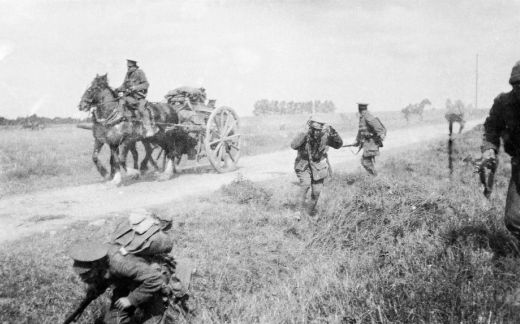
1st Middlesex first line transport hit by shrapnel at Signy Signets 9 horses are killed and a water cart riddled. The man in the centre running into the ditch belongs to the Intelligence Corps, he is badly wounded and his head and face is covered in blood. Battle of the Marne 8 September 1914.
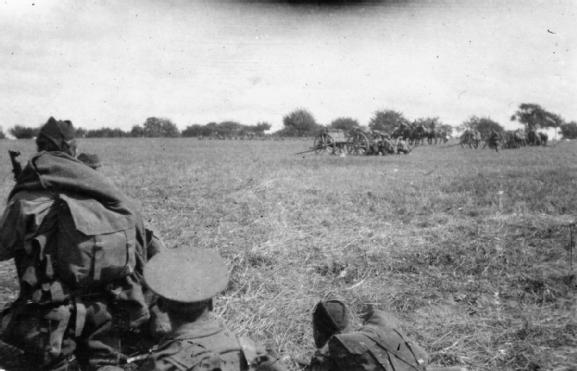
Battle of the Marne.A British 18 pounder comes into action at Signy-Signets. 8 September 1914. Bottom left, men of the 1st Battalion Cameronians (Scottish Rifles)
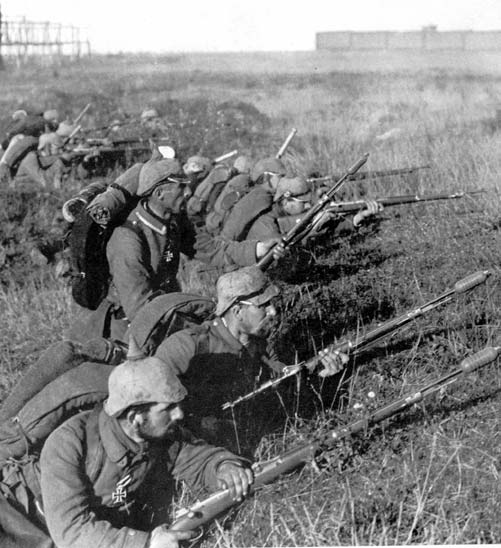
German troops at the Battle of the Marne September 1914
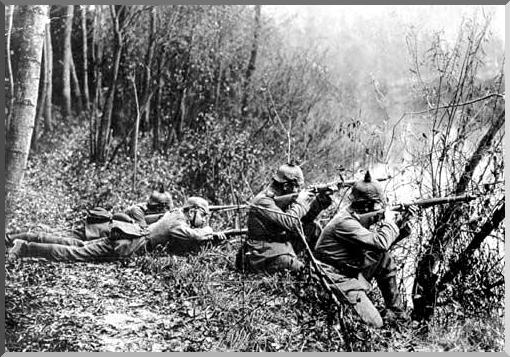
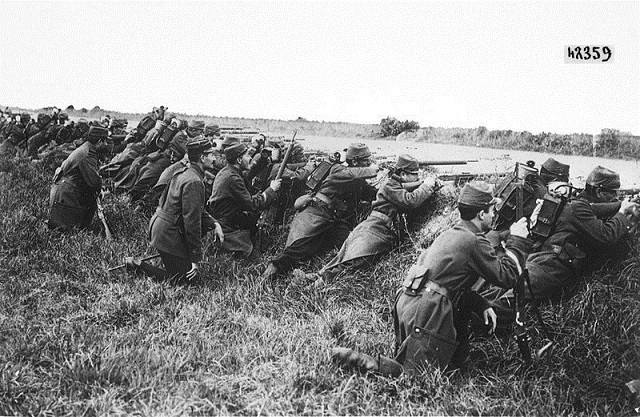
French troops at the Marne
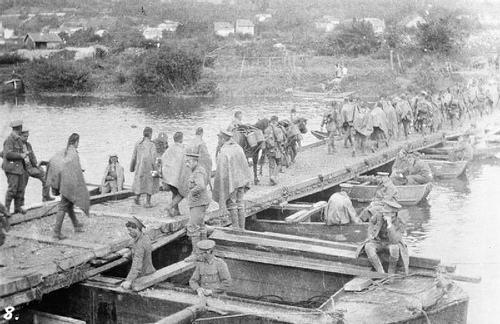
The Company trail 1-10 September;
September was mainly marching and bivouacking. At Dammartin the Company improved the water supply before moving on.
On 6th September the retreat turned into an advance. 7 Coy were with 11th Bde who were, at this time, and for the next few days, acting reserve for 4th Division, which in turn was in support of the 1st Army directly engaged with the enemy to the east.
At La Ferte sous Jouarre the Company built a Pontoon Bridge together with 9 Field Company over the River Marne 9/10 Sep 1914.
On the 10 September the Coy manned the bridge all day.
11 Sep the Company dismantled the bridge.
September was mainly marching and bivouacking. At Dammartin the Company improved the water supply before moving on.
On 6th September the retreat turned into an advance. 7 Coy were with 11th Bde who were, at this time, and for the next few days, acting reserve for 4th Division, which in turn was in support of the 1st Army directly engaged with the enemy to the east.
At La Ferte sous Jouarre the Company built a Pontoon Bridge together with 9 Field Company over the River Marne 9/10 Sep 1914.
On the 10 September the Coy manned the bridge all day.
11 Sep the Company dismantled the bridge.
The long retreat comes to an end 6th September 1914, The Allies counter attack at the Marne and push the once unstoppable Germans back to the north side of the River Aisne
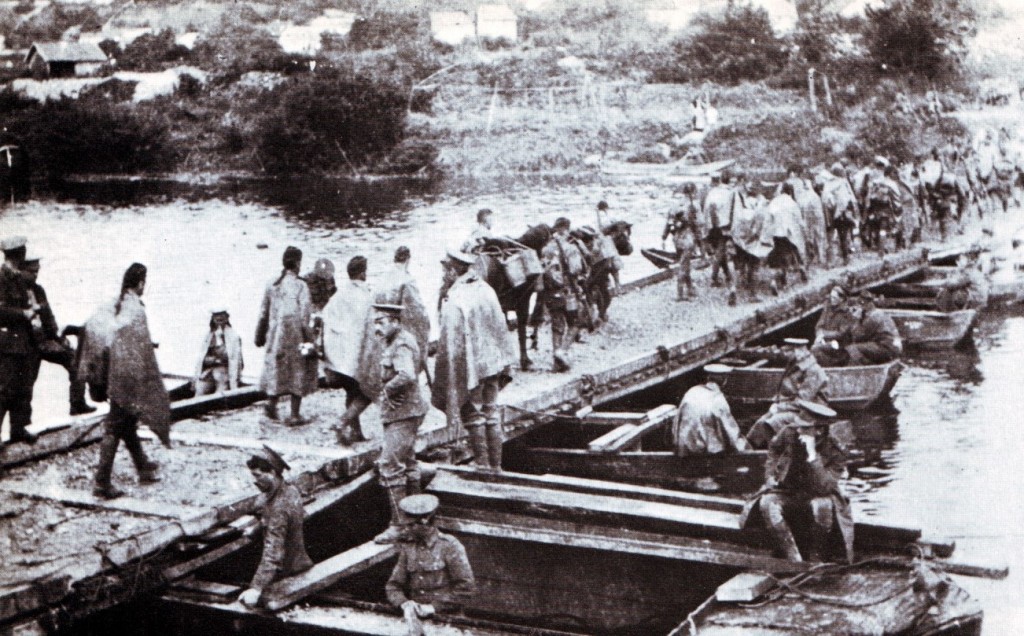
7 Field Company manning the pontoon bridge over the River Marne 10 September 1914. 'D’ Company 1st Battalion the Cameronians (Scottish Rifles) are seen here crossing the bridge. The following day at 4.15 am 7 Field Company started dismantling the bridge
Plan of the Marne Pontoon Bridge at La Ferte sous Jouarre
The plan copied from 9 Field Company War Diary Sep 1914
The plan copied from 9 Field Company War Diary Sep 1914
The damaged stone bridge can be seen in the background
12 Sep. Marched at 7am Chateau via Maucreux to Tigny and billeted in a farm at 6pm. We march off west 20 miles in the pouring rain. For the first time we bivouac in a draughty barn
13 Sep. Paraded at 3.30.am and marched to Le Pavilion 1 mile N of Rozieres. Halted for breakfast. Proceeded via Billy to Venizel in company with 9th Company. Constructed a bridge over the River Aisne of Company material and casks. Withdrew at 3.30.pm and bivouacked at Vignolles 2 miles S of Soissons with 2nd Bridging Train. We rise at 2.30.am and breakfast at 3.am, half an hour later march off to build another bridge. Our infantry and artillery are heavily engaged. We advance at 10.am to build bridge, but owing to being shelled we take cover behind a house . After a time we carefully make our way into Venizel. Passing on our way numerous dead and wounded of the Kings Own Rifles. We prepare the raft for the bridge for the 9th Company to complete, whilst we at 3.pm are ordered to Soissons to put up a heavy pontoon bridge. To do this we have to march 12 miles when we bivouac in the rain for the night
14 Sep. Paraded at 7.am and attempted to bridge the River Aisne at Soissons. Prevented by fire from a heavy battery and gave up the attempt at 1.pm. Withdrew to Vignolles. After waking up at 5.am in pools of water we are detailed in parties. I am the general's orderly. My work consists of showing the pontoon drivers the way to the river. Shells are dropping all over the place, a piece dropped not 6 foot from me so I retired to a doorway and none too soon for had I stopped where I was I should no doubt have been in little pieces! The Company had to give up the attempt to put up a bridge as the Germans had observed us making the bridge and heavily shelled the position. We retired to a goods yard warehouse, where 16 men were are told to recover the pontoons at night, which was safely done. We had a message read out to us from the General, congratulating us on the bridge over the Marne
15 Sep. Paraded at 9.30.am and marched to Venizel. No1 Section took over control of floating bridge. The other 3 Sections were allotted to the 3 Brigades but were concentrated at St Marguerite and undertook work from 8.pm to 1.am in connection with defences 1/2 mile N of the village. Work was interupted at 11.pm for 1/2 hour by an attack on the E flank. No casualties. HQ of the Company remained at Venizel. We leave Soissons at 8.30.am to return to the 11 Inf Bde. We cross the Aisne and advance in extended order towards Bucy-le-Long but have to retire on account of heavy shelling on the left. We once more set off but more to the right towards St Marguerite, and are successful in reaching Brigade HQ. We have dinner under cover of a church at St Marguerite. We see several wounded taken into the church which is being used as a hospital. The 'Kings Own' borrow our shovels to dig graves. After resting a while we go up a dark muddy lane, the hill with pick and shovel full marching order. It is pouring in torrents. When we had dug 2ft down we were surprised by German rifle fire, so down we had to lay in our trench. We eventually finish and scramble back to the village. We found shelter in a small room,it is almost as bad as the 'Black Hole' of Calcutta, we laid down, or rather sat down and went to sleep wet and hungry.
13 Sep. Paraded at 3.30.am and marched to Le Pavilion 1 mile N of Rozieres. Halted for breakfast. Proceeded via Billy to Venizel in company with 9th Company. Constructed a bridge over the River Aisne of Company material and casks. Withdrew at 3.30.pm and bivouacked at Vignolles 2 miles S of Soissons with 2nd Bridging Train. We rise at 2.30.am and breakfast at 3.am, half an hour later march off to build another bridge. Our infantry and artillery are heavily engaged. We advance at 10.am to build bridge, but owing to being shelled we take cover behind a house . After a time we carefully make our way into Venizel. Passing on our way numerous dead and wounded of the Kings Own Rifles. We prepare the raft for the bridge for the 9th Company to complete, whilst we at 3.pm are ordered to Soissons to put up a heavy pontoon bridge. To do this we have to march 12 miles when we bivouac in the rain for the night
14 Sep. Paraded at 7.am and attempted to bridge the River Aisne at Soissons. Prevented by fire from a heavy battery and gave up the attempt at 1.pm. Withdrew to Vignolles. After waking up at 5.am in pools of water we are detailed in parties. I am the general's orderly. My work consists of showing the pontoon drivers the way to the river. Shells are dropping all over the place, a piece dropped not 6 foot from me so I retired to a doorway and none too soon for had I stopped where I was I should no doubt have been in little pieces! The Company had to give up the attempt to put up a bridge as the Germans had observed us making the bridge and heavily shelled the position. We retired to a goods yard warehouse, where 16 men were are told to recover the pontoons at night, which was safely done. We had a message read out to us from the General, congratulating us on the bridge over the Marne
15 Sep. Paraded at 9.30.am and marched to Venizel. No1 Section took over control of floating bridge. The other 3 Sections were allotted to the 3 Brigades but were concentrated at St Marguerite and undertook work from 8.pm to 1.am in connection with defences 1/2 mile N of the village. Work was interupted at 11.pm for 1/2 hour by an attack on the E flank. No casualties. HQ of the Company remained at Venizel. We leave Soissons at 8.30.am to return to the 11 Inf Bde. We cross the Aisne and advance in extended order towards Bucy-le-Long but have to retire on account of heavy shelling on the left. We once more set off but more to the right towards St Marguerite, and are successful in reaching Brigade HQ. We have dinner under cover of a church at St Marguerite. We see several wounded taken into the church which is being used as a hospital. The 'Kings Own' borrow our shovels to dig graves. After resting a while we go up a dark muddy lane, the hill with pick and shovel full marching order. It is pouring in torrents. When we had dug 2ft down we were surprised by German rifle fire, so down we had to lay in our trench. We eventually finish and scramble back to the village. We found shelter in a small room,it is almost as bad as the 'Black Hole' of Calcutta, we laid down, or rather sat down and went to sleep wet and hungry.
At each side of the river where the Pontoon Bridge crossed, The French erected a memorial dedicated to 4 Division Royal Engineers.
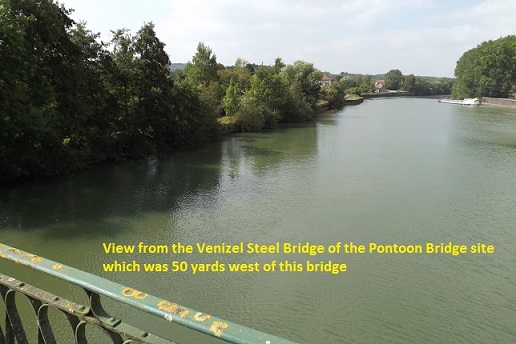
Venizel Bridge plan taken from 9 Field Company's war diary
Extract from Pioneer J.E. Daniels's diary 15 September 1914: We have dinner under cover of a church at St Marguerite. We see several wounded taken into the church which is being used as a hospital. The 'Kings Own' borrow our shovels to dig graves. After resting a while we go up a dark muddy lane, the hill with pick and shovel full marching order. It is pouring in torrents. When we had dug 2ft down we were surprised by German rifle fire, so down we had to lay in our trench. We eventually finish and scramble back to the village. We found shelter in a small room,it is almost as bad as the 'Black Hole' of Calcutta, we laid down, or rather sat down and went to sleep wet and hungry.
Note the high ground in the background. This is where the Germans retreated to, dug in, and placed their guns.
16 Sep. An attempt was made at 8.am to send Regimental transport into St Marguerite from Venizel but it was stopped by shell fire, and rations etc.were brought up by mounted orderlies. Paraded at 8.am. Nos 2 and 4 Sections for work with the 'Inniskillings' and No 3 Section for work with the 'Kings Own'. No1 Section remained on the bridge at Venizel, which was shelled without damage during the morning. Awake somewhere about 6.am looking very dilapidated after last night's work. We clean up and I am on guard over a water trough. The Germans are constantly shelling but owing to this village being under a hill they can do no damage. We are put on 1/4 rations, as no supplies have arrived yet. At 7.30.pm we take picks and shovels and dig another trench. We have to work very quietly and manage to finish by 12.30.am.
17 Sep. In the evening No1 Section was brought up to St Marguerite (some text Crossed out) Work was carried on as follows: No 3 Section with Centre Section of defence. No 4 Section erecting barb wire and flares and cleaning brushwood in front of trenches with the 'Essex' Regt. All work was carried out after dark. Cpl Wiltam and two Sappers of No 2 Section sent back sick. No 3 Forage Cart gnashed up.The Germans are shelling Bucy-le-Long doing considerable damage. Five MP's are killed in a house. We have no work tonight.
18-21 Sep. Work carried out in the lines by all Sections as requisite. This consisted chiefly in making shelters by day and erecting wire entanglements and overhead cover in the forward trenches by night. 2 Sections of the 9th Coy were brought up to the left Section and placed under orders of the OC 7th Coy. Capt G.B.O Symonds RE arrived and took over command of the Company. 14 Sappers arrived from base to replace casualties. Lcpl Spiers returned to base sick. Reveille at 5.am. We have more roomier quarters. I am sleeping in a wine cellar. We parade for work at 10.am for improving trenches, whilst doing so we are shelled though no one is hit. We finish at 2.pm and go out again at 7.30.pm finishing our work for the 'Essex Regt' by midnight.
19 Sep. Parade at 10.am for work until 1.30.pm. We parade again at 7.30.pm to put up an entanglement in front of the advance trenches. We finish this at 11.30.pm
20 Sep. We have nothing to do during the day but at 6.pm we go to improve trenches and make dug-outs, finishing at 12.pm
21 Sep. We make overhead cover in the trenches from 8.30.am until 12.pm (noon). We carry on with the same work from 3.pm to 6.pm. We have the night in
22 Sep. Work as requisites including night work. We parade for trench improvements but ordered back on account of heavy shelling . Our artillery are at it all the morning. We go up to the trenches at 7.pm improving them until 12 o'clock.
23 Sep. Work as requisites. St Marguerite was heavily shelled by a battery of field guns. Sapper Horsford No 4 Section was wounded by a splinter. We have a bit of sunshine, it is quite a change from the rain. At 8.30.pm we go to find wood suitable for making dug-outs. Sapper Horseford is struck in the neck by a piece of shell and is taken to hospital. Very heavy shelling all day long
24 Sep. All Sections working on their parts of the position. Shell fire as usual. The HQ of the company still remained at Venizel. We parade at 8.30.am to make shelters for the 'Essex Regt', for sleeping in. We finish at 3.pm and have the night in.
25-27 Sep. All Sections worked on trenches, barbed wire and other obstacles, head cover, communications and shelters. Sections had a considerable amount of night work, as in many cases work was in view of the enemy in daylight. Work again in the trenches from 8.30.am until 1.30.pm. We have nothing to do in the afternoon but at 7.30.pm we put up an entanglement finishing at midnight.
26 Sep. The sun continues to shine. We parade for work at 10am cutting a way through a wood until 12.30.pm. Parade at 7.pm and put up more entanglements and finish by 9.30.pm
27 Sep. We have the day off but parade at 1.30.pm for trenching, returning at 7.30.pm. We had new boots issued to us, which were very badly needed
28 Sep. All Sections working. Three out at night working on advanced trenches with infantry of the 12th Brigade. During this and proceeding days the Company was frequently employed on improving roads, sanitary arrangements etc. This and all the other work also involved the collection of materials in the neighbourhood, barbed wire from fences, wood from buildings. We make brushwood hurdles in the afternoon and dig a trench for the 'kings Own' at 11.30.pm finishing at 4.am
29-30 Sep. All Sections working on their positions, largely night work, barbed wire, shelters, artillery observation post etc. A note on strength, casualties for September is attached. Cut 5 ft pickets for wire entanglements. Aeroplane dropped bomb close to us, made a horrible smell, we soon finished and came back. In the afternoon prepared pickets up the hill for the L.Fb headquarters, came back for tea and returned afterwards. The infantry had not finished so we gave a hand, but had hardly commenced when orders came that we had to cease work as an attack was expected
30 Sep. We again went up to L.Fb, but found that they had to increase the depth of the dug-out to 7ft so we commenced cutting brushwood, owing to the felling of a large tree we drew the enemies fire. Four of our fellows had a narrow escape. Work being impossible we returned and made brushwood hurdles. We went up to the dug-out at night and finished excavating. We drew shrapnel fire again but no harm came of it, we covered the dug-out over.
17 Sep. In the evening No1 Section was brought up to St Marguerite (some text Crossed out) Work was carried on as follows: No 3 Section with Centre Section of defence. No 4 Section erecting barb wire and flares and cleaning brushwood in front of trenches with the 'Essex' Regt. All work was carried out after dark. Cpl Wiltam and two Sappers of No 2 Section sent back sick. No 3 Forage Cart gnashed up.The Germans are shelling Bucy-le-Long doing considerable damage. Five MP's are killed in a house. We have no work tonight.
18-21 Sep. Work carried out in the lines by all Sections as requisite. This consisted chiefly in making shelters by day and erecting wire entanglements and overhead cover in the forward trenches by night. 2 Sections of the 9th Coy were brought up to the left Section and placed under orders of the OC 7th Coy. Capt G.B.O Symonds RE arrived and took over command of the Company. 14 Sappers arrived from base to replace casualties. Lcpl Spiers returned to base sick. Reveille at 5.am. We have more roomier quarters. I am sleeping in a wine cellar. We parade for work at 10.am for improving trenches, whilst doing so we are shelled though no one is hit. We finish at 2.pm and go out again at 7.30.pm finishing our work for the 'Essex Regt' by midnight.
19 Sep. Parade at 10.am for work until 1.30.pm. We parade again at 7.30.pm to put up an entanglement in front of the advance trenches. We finish this at 11.30.pm
20 Sep. We have nothing to do during the day but at 6.pm we go to improve trenches and make dug-outs, finishing at 12.pm
21 Sep. We make overhead cover in the trenches from 8.30.am until 12.pm (noon). We carry on with the same work from 3.pm to 6.pm. We have the night in
22 Sep. Work as requisites including night work. We parade for trench improvements but ordered back on account of heavy shelling . Our artillery are at it all the morning. We go up to the trenches at 7.pm improving them until 12 o'clock.
23 Sep. Work as requisites. St Marguerite was heavily shelled by a battery of field guns. Sapper Horsford No 4 Section was wounded by a splinter. We have a bit of sunshine, it is quite a change from the rain. At 8.30.pm we go to find wood suitable for making dug-outs. Sapper Horseford is struck in the neck by a piece of shell and is taken to hospital. Very heavy shelling all day long
24 Sep. All Sections working on their parts of the position. Shell fire as usual. The HQ of the company still remained at Venizel. We parade at 8.30.am to make shelters for the 'Essex Regt', for sleeping in. We finish at 3.pm and have the night in.
25-27 Sep. All Sections worked on trenches, barbed wire and other obstacles, head cover, communications and shelters. Sections had a considerable amount of night work, as in many cases work was in view of the enemy in daylight. Work again in the trenches from 8.30.am until 1.30.pm. We have nothing to do in the afternoon but at 7.30.pm we put up an entanglement finishing at midnight.
26 Sep. The sun continues to shine. We parade for work at 10am cutting a way through a wood until 12.30.pm. Parade at 7.pm and put up more entanglements and finish by 9.30.pm
27 Sep. We have the day off but parade at 1.30.pm for trenching, returning at 7.30.pm. We had new boots issued to us, which were very badly needed
28 Sep. All Sections working. Three out at night working on advanced trenches with infantry of the 12th Brigade. During this and proceeding days the Company was frequently employed on improving roads, sanitary arrangements etc. This and all the other work also involved the collection of materials in the neighbourhood, barbed wire from fences, wood from buildings. We make brushwood hurdles in the afternoon and dig a trench for the 'kings Own' at 11.30.pm finishing at 4.am
29-30 Sep. All Sections working on their positions, largely night work, barbed wire, shelters, artillery observation post etc. A note on strength, casualties for September is attached. Cut 5 ft pickets for wire entanglements. Aeroplane dropped bomb close to us, made a horrible smell, we soon finished and came back. In the afternoon prepared pickets up the hill for the L.Fb headquarters, came back for tea and returned afterwards. The infantry had not finished so we gave a hand, but had hardly commenced when orders came that we had to cease work as an attack was expected
30 Sep. We again went up to L.Fb, but found that they had to increase the depth of the dug-out to 7ft so we commenced cutting brushwood, owing to the felling of a large tree we drew the enemies fire. Four of our fellows had a narrow escape. Work being impossible we returned and made brushwood hurdles. We went up to the dug-out at night and finished excavating. We drew shrapnel fire again but no harm came of it, we covered the dug-out over.
Le Ferte sous Jouarre
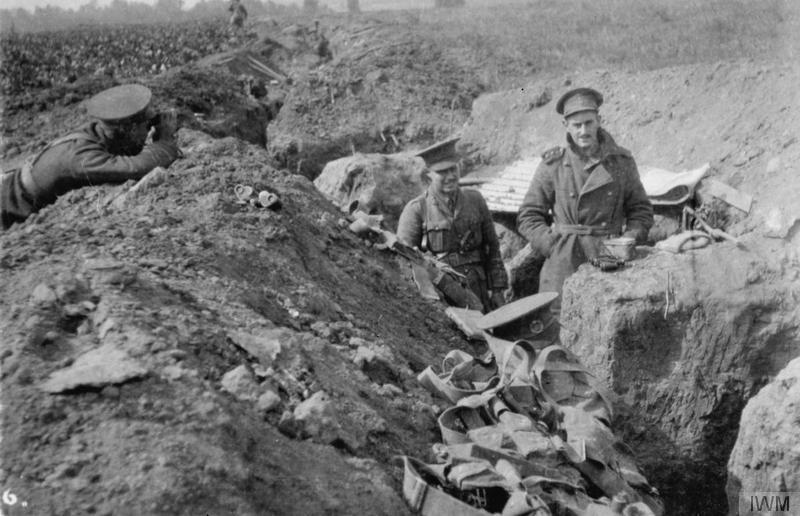
Capt E.M. Maitland of the 2nd Battalion the Essex Regiment in a front line trench at St Marguerite
17 September 1914. 7 Coy worked on these early trenches including clearing brushwood and barbed wire defences
17 September 1914. 7 Coy worked on these early trenches including clearing brushwood and barbed wire defences
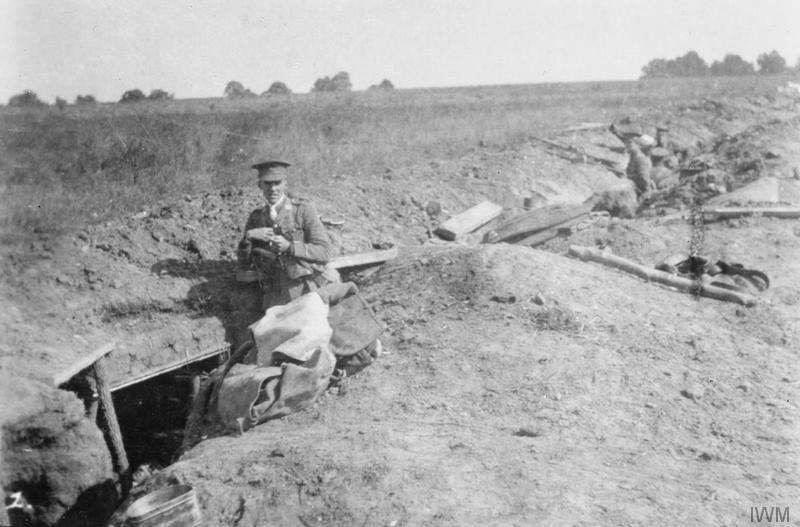
1st Battalion Kings Own (Royal Lancaster Regiment) in front line trenches at St Marguerite 22nd September 1914
7 Coy supported the Kings Own and worked on these early trenches 15 September- 4 October 1914
7 Coy supported the Kings Own and worked on these early trenches 15 September- 4 October 1914
Photo below- courtesy IWM. http://www.iwm.org.uk/collections/photographs
Photo below- courtesy IWM. http://www.iwm.org.uk/collections/photographs
Right: This photo is of the area up the hill from St Marguerite village where the 4th Division dug their first trenches in September 1914. The trenches dug here were some of the earliest trenches of WW1.
At this stage of the war the sappers had to go around the farms and buildings in the neighbourhood collecting material for defences, such as, barbed wire, wood, stakes, etc.
At this stage of the war the sappers had to go around the farms and buildings in the neighbourhood collecting material for defences, such as, barbed wire, wood, stakes, etc.
8 Oct. Marched with 11th Brigade via Hartennes to Billy Sur Ourcq arriving 4am, billeted. Marched again with 11th Brigade at 5pm to Largny via Corey and Villers Cotterete. Arrived 2.30am, having had a two hour halt for a meal enroute. Had a fairly good sleep in a cow shed, its getting very cold now, frosty at nights. At 1.30.pm I was sent to Brigade Headquarters for orders and returned at 5.30.pm to find the Company gone, followed them up and finally arrived at our billet at 3.am. We passed through Villiers Cotterettes, a fairly large town in which there were a very large number of French Motor transport. Our bedroom is a hay-loft a very comfortable change. It is the warmest sleep I have had for some time.
9 Oct. Marched with 11th Brigade at 2.30pm via Vez and Bethan Court to Nery. Arrived 9.20.pm and billeted. Left our bivouac at 2.30pm, it is a fine day, after a long and tiring march we arrive at Nery of L Battery fame, we slept in another cow-shed.
10 Oct. Marched independently at 1.pm via Villeneuve to Pontpoint. Arrived 4.pm, billetted. Lt Macready was employed as RTO at Pont St Maxence on this and following day. Arose about 8.30.am and marched till 4.pm. We billeted at a farm just outside Pont-St-Maxence. The Germans had visited this farm from which they had taken 3 cows. I am sent with Elms to the railway station to act as orderlies. I had one message to deliver during the night.
9 Oct. Marched with 11th Brigade at 2.30pm via Vez and Bethan Court to Nery. Arrived 9.20.pm and billeted. Left our bivouac at 2.30pm, it is a fine day, after a long and tiring march we arrive at Nery of L Battery fame, we slept in another cow-shed.
10 Oct. Marched independently at 1.pm via Villeneuve to Pontpoint. Arrived 4.pm, billetted. Lt Macready was employed as RTO at Pont St Maxence on this and following day. Arose about 8.30.am and marched till 4.pm. We billeted at a farm just outside Pont-St-Maxence. The Germans had visited this farm from which they had taken 3 cows. I am sent with Elms to the railway station to act as orderlies. I had one message to deliver during the night.
11 Oct. Remained at Pont Point. Arose at 6.am and went to our billet for the days rations and had just returned when I had a message to deliver R.F.A. I at last managed to get breakfast at 9.am. The people here are very hospitable and are the best dressed I have seen yet in France. Had one message to deliver at night to our Company.
12 Oct. Nos 3 and 4 Sections and all vehicles and horses marched at 3.30.am to entrain at Pont St Maxence. Remainder of Company marched at 5.pm. Train started at 8.40.am. Travelled via Creil, Armiens and Etaples to Blendecques, three miles south of St Omer. Detrained and marched to Hondeghem. Woke Mr Macready at 4am and we all entrained leaving the station at 7.30.am in the cattle trucks. We passed through several fairly large towns. At 10.am we arrived at Amiens, at Etaples we received a warm reception from the public, also at Le Touquet and various other stations. We finally detrained at Blendeaques at 9.pm. After unloading we had a long march to Caestre, arriving at 5.am. It was very cold and had just commenced to rain.
12 Oct. Nos 3 and 4 Sections and all vehicles and horses marched at 3.30.am to entrain at Pont St Maxence. Remainder of Company marched at 5.pm. Train started at 8.40.am. Travelled via Creil, Armiens and Etaples to Blendecques, three miles south of St Omer. Detrained and marched to Hondeghem. Woke Mr Macready at 4am and we all entrained leaving the station at 7.30.am in the cattle trucks. We passed through several fairly large towns. At 10.am we arrived at Amiens, at Etaples we received a warm reception from the public, also at Le Touquet and various other stations. We finally detrained at Blendeaques at 9.pm. After unloading we had a long march to Caestre, arriving at 5.am. It was very cold and had just commenced to rain.
13 Oct. Arrived Hondeghem 5.30am and billeted. Marched again at 10.am in rear of 11th Brigade to a point one mile East of Caestre. The Division was in action again during the afternoon to the East of Fletre and captured a position running North and South through Metcren, held by German Cavalry and cyclists. Billeted one mile West of Fletre. The pontoon and Tresle wagons were left (with those of 9 Coy) at Caestre. We had breakfast at 7.15.am and commenced marching again at 10.30.am. It was raining hard and continued all day. We halted at 3.pm as our infantry had caught up with the Germans. Our artillery was giving them socks! At last we moved off and finally billeted in a farm where we had a decent sleep.
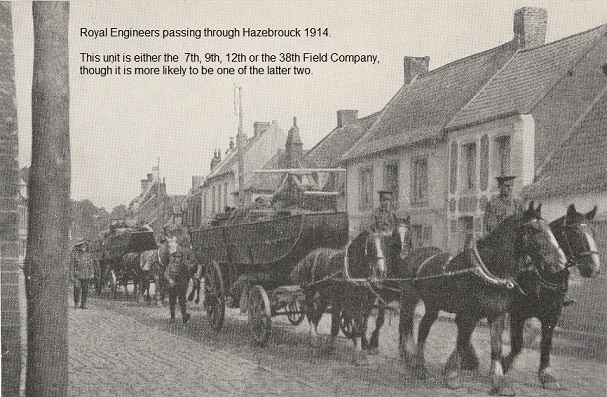
14 Oct. Nos 1 and 2 Sections marched with Divisional advance guard to Bailleul in the morning. No 3 Section returned to Caestre to load all superstructure on Trestle wagons, the Trestles being removed to pontoon wagons. This with a view to the bridging of small streams in Belgium. On return of No 3 Section, with Trestle wagons, Company marched at 1.15.pm with 12th Brigade to Bailleul. Billeted at 7.pm. Company reinforced by rank and file from Base. Had a hurried breakfast and marched off. The Germans having retreated over the frontier. It is pouring with rain, we halt for dinner and then march on to Bailleul a town of 13,000 inhabitants. Here we capture two German Cavalrymen and go on a wild goose chase for another one. The people are very kind, giving us sweets, fruit and matches etc. We slept at a brewery and had a fairly good sleep. The Germans had been here.
15 Oct . Remained in bailleul. No 3 and 4 Sections marched at 5pm to Nieppe.many delays on the road to Nieppe, was reached only at 3.30 am. The Sections were ordered to assist Somerset LI putting Nieppe in state of defence. Capt Symons and Lt Wright were sent to reconnoitre Erquinghem Bridge which was found to be held by the enemy. After daybreak Capt Symons, again reconnoitred and was able to cross the bridge (it was subsequently reoccupied for part of the day by the enemy) Arose at 5.am and had breakfast at 5.30.am. Received two parcels of papers and writing paper from Phil. We were going to be paid but there was not enough money to pay us with. A lady who could speak English said that "now you have come we have forgotten half our troubles", continuing she said "There was no word bad enough to describe the German's conduct" This place has escaped very lightly for we saw only two houses burnt, tho' most of the houses had been broken open. We were supposed to move at 5 pm but did not.
15 Oct . Remained in bailleul. No 3 and 4 Sections marched at 5pm to Nieppe.many delays on the road to Nieppe, was reached only at 3.30 am. The Sections were ordered to assist Somerset LI putting Nieppe in state of defence. Capt Symons and Lt Wright were sent to reconnoitre Erquinghem Bridge which was found to be held by the enemy. After daybreak Capt Symons, again reconnoitred and was able to cross the bridge (it was subsequently reoccupied for part of the day by the enemy) Arose at 5.am and had breakfast at 5.30.am. Received two parcels of papers and writing paper from Phil. We were going to be paid but there was not enough money to pay us with. A lady who could speak English said that "now you have come we have forgotten half our troubles", continuing she said "There was no word bad enough to describe the German's conduct" This place has escaped very lightly for we saw only two houses burnt, tho' most of the houses had been broken open. We were supposed to move at 5 pm but did not.
16 Oct. The headquarters and Nos 1 and 2 Sections marched independently at 11am from Bailleul. No1 and 2 Sections joined 12th Brigade at Ploegsteert at 3.pm and assisted the Inniskillen Fusiliers in strengthening their position 1/2 mile East of that village. These Sections and the others in Nieppe worked part of the night.. Company headquarters reached Nieppe at 1.pm and remained in billets there. Arose at 5.am had breakfast and paraded for pay, drew 4 Fr. An hour after we left the town, passing thro' Romarin a frontier village at midday. We proceeded straight to our work near Ploegsteert, putting up wire entanglement. We finished and came back to a farm for the night. Everything is much cheaper here, whereas in France, bread was a franc a loaf. Here it is only 4c.
Saturday 17 Oct. No1 and 2 Sections worked from daybreak and after a rest, during the remainder of the day. Nos 3 and 4 remained in Nieppe. Headquarters marched at 8.30am via Romarin and billeted 3/4 mile West of Ploegsteert. The Trestle wagon was left in Nieppe. At 3.pm No 3 and 4 Sections marched with 9th Co RE, and bridging equipment of both Companies (which had just come in from Bailleul), to Armentieres and Houplines to repair bridges, all being under the command of O.C 9th Coy. RE. During the afternoon the Division was moving forward to a line Le Gheer, Houplines, Armentiers. The latter place was evacuated by the enemy without any resistance during the day. Arose at 4.am and proceeded to continue putting up the barbed wire round the reserve trenches. We worked at it until 5.30.pm when we advanced to Le Gheer to dig some trenches. We finished at 4.am the next morning.
Sunday 18 Oct. Nos 3 and 4 Sections billeted in Houplines after doing entrenching during the previous night near Le Gheer. No1 and 2 Sections moved during the afternoon to Le Bizet. We had breakfast at 7.30.am and then went to sleep till tea time. I was tired out. We left billet about 5.30.pm for Bizet. We dug trenches in Le Touquet which was on fire in different places. It was a grand yet awful sight. We finished digging at 4.am.
Saturday 17 Oct. No1 and 2 Sections worked from daybreak and after a rest, during the remainder of the day. Nos 3 and 4 remained in Nieppe. Headquarters marched at 8.30am via Romarin and billeted 3/4 mile West of Ploegsteert. The Trestle wagon was left in Nieppe. At 3.pm No 3 and 4 Sections marched with 9th Co RE, and bridging equipment of both Companies (which had just come in from Bailleul), to Armentieres and Houplines to repair bridges, all being under the command of O.C 9th Coy. RE. During the afternoon the Division was moving forward to a line Le Gheer, Houplines, Armentiers. The latter place was evacuated by the enemy without any resistance during the day. Arose at 4.am and proceeded to continue putting up the barbed wire round the reserve trenches. We worked at it until 5.30.pm when we advanced to Le Gheer to dig some trenches. We finished at 4.am the next morning.
Sunday 18 Oct. Nos 3 and 4 Sections billeted in Houplines after doing entrenching during the previous night near Le Gheer. No1 and 2 Sections moved during the afternoon to Le Bizet. We had breakfast at 7.30.am and then went to sleep till tea time. I was tired out. We left billet about 5.30.pm for Bizet. We dug trenches in Le Touquet which was on fire in different places. It was a grand yet awful sight. We finished digging at 4.am.
23 Oct. Nos 1,2 and 3 Sections at work again at night. No 4 Section joined 12th Brigade and marched to Nieppe. We had breakfast at 8.30.am and then collected more pickets. We had nothing to do after. At 5.30.pm we started out to the scene of last night's adventure. We put up one entanglement but as it was too light and much nearer the enemies trenches we could not put up the second one. We had nearly arrived back when the Germans attacked our trenches, we were well out of it however. We arrived home at 2.30.am.
24 Oct. Section commanders supervised civilian labour working on second line entanglements during the day. Sections worked on barbed wire entanglements etc in first line by night. We had breakfast and heard that the 1st and 2nd Division have captured 500 prisoners besides killing 1000 of the enemy last night. At 11.am we left our billet for an unknown destination. We returned about 1.pm having gone on a wild goose chase. During the afternoon we made a trip wire entanglement ready for putting up tonight. Received three letters, one dated August 28th! Fixed the entanglement and arrived back at 1.30.am.
25-29 Oct. All sections continued to be employed as above. No4 Section was billeted at Nieppe. No 1 between Le Bizet and Ploegsteert and the remainder of the Company in Ploegsteert. We had nothing to do during the day. I am on guard duty today. It is raining hard. The Section returned from work a 11.30.pm. Two months from Xmas!
26 Oct. We had breakfast about 8.am and collected wood for pickets after which we made entanglements on 2nd line of defence. Went out again 6.45.pm but could do nothing owing to a fire at a convent so we returned at 11.30.pm. I received a parcel from home.
27 Oct. Breakfast at 8 am and paraded for work at 10.am for wire entanglements on 2nd line. We finish at 2.30 pm. We went to St Yves at 6.45.pm but could do no work as our artillery shelled and fired a house in which Germans were suspected of placing a machine gun. We returned to billet about 6.am.
28 Oct. Arose about 8.30.am. At 9.45.am we went to second line and worked on barbed wire. At 2.30.pm we returned to billet. At 12.30.am we went to first line and fixed a low wire entanglement returning to billet at 5.am.
29 Oct. Got up at 9.am and at 9.45.am again went to the barbed wire entanglement returning about 1.30.pm to dinner. Paraded at 7.30.pm to put up wire entanglements.
30 Oct. Part of the positions held by the 4th Division was attacked vigorously during the days. Civilian labour worked where possible on second line entanglements under supervision RE officers. No 2 Section were shelled while working on second line in day time. No 1, 2 and 3 Sections worked on barbed wire entanglements etc for 11th Brigade at night as usual. No 4 Section continued to be employed by 12th Brigade. Had breakfast and went up to help supervise civilians digging trenches. On arriving there however, we found no civilians as shells were dropping thick and heavy. At night we went up to the trenches and built barricades. The Germans had charged during the day and lay about in hundreds. Our barbed wire had proved an effective barrier. We had plenty of souvenirs.
31 Oct. Sections worked as before. A note on Strength and Casualties etc is attached for Oct. Got up about 8.30 am and after breakfast we finished the wiring on the 2nd line of defence. We paraded for work about 7 pm and put up 700 yds of wire entanglements working with No3 Section-returned about 3 am.
24 Oct. Section commanders supervised civilian labour working on second line entanglements during the day. Sections worked on barbed wire entanglements etc in first line by night. We had breakfast and heard that the 1st and 2nd Division have captured 500 prisoners besides killing 1000 of the enemy last night. At 11.am we left our billet for an unknown destination. We returned about 1.pm having gone on a wild goose chase. During the afternoon we made a trip wire entanglement ready for putting up tonight. Received three letters, one dated August 28th! Fixed the entanglement and arrived back at 1.30.am.
25-29 Oct. All sections continued to be employed as above. No4 Section was billeted at Nieppe. No 1 between Le Bizet and Ploegsteert and the remainder of the Company in Ploegsteert. We had nothing to do during the day. I am on guard duty today. It is raining hard. The Section returned from work a 11.30.pm. Two months from Xmas!
26 Oct. We had breakfast about 8.am and collected wood for pickets after which we made entanglements on 2nd line of defence. Went out again 6.45.pm but could do nothing owing to a fire at a convent so we returned at 11.30.pm. I received a parcel from home.
27 Oct. Breakfast at 8 am and paraded for work at 10.am for wire entanglements on 2nd line. We finish at 2.30 pm. We went to St Yves at 6.45.pm but could do no work as our artillery shelled and fired a house in which Germans were suspected of placing a machine gun. We returned to billet about 6.am.
28 Oct. Arose about 8.30.am. At 9.45.am we went to second line and worked on barbed wire. At 2.30.pm we returned to billet. At 12.30.am we went to first line and fixed a low wire entanglement returning to billet at 5.am.
29 Oct. Got up at 9.am and at 9.45.am again went to the barbed wire entanglement returning about 1.30.pm to dinner. Paraded at 7.30.pm to put up wire entanglements.
30 Oct. Part of the positions held by the 4th Division was attacked vigorously during the days. Civilian labour worked where possible on second line entanglements under supervision RE officers. No 2 Section were shelled while working on second line in day time. No 1, 2 and 3 Sections worked on barbed wire entanglements etc for 11th Brigade at night as usual. No 4 Section continued to be employed by 12th Brigade. Had breakfast and went up to help supervise civilians digging trenches. On arriving there however, we found no civilians as shells were dropping thick and heavy. At night we went up to the trenches and built barricades. The Germans had charged during the day and lay about in hundreds. Our barbed wire had proved an effective barrier. We had plenty of souvenirs.
31 Oct. Sections worked as before. A note on Strength and Casualties etc is attached for Oct. Got up about 8.30 am and after breakfast we finished the wiring on the 2nd line of defence. We paraded for work about 7 pm and put up 700 yds of wire entanglements working with No3 Section-returned about 3 am.
Le Touquet: 18 October 1914, the 2nd Bn Lancashire Fusiliers and 1st King's Own of 12 Inf Bde captured most of Le Touquet and dug in, forming the front line, which was more or less to remain throughout the war. Sections of 7 Coy were employed 18 October 1914 - 29 April 1915 building and maintaining the railway barricade, trenches and Le Touquet defences often in wet and very cold conditions. This area was a hot spot for sniping and shelling exchanges.
''C'' Coy 2nd Bn Lancashire Fusiliers at the Barricade in Le Touquet
November 1914
1 Nov. Sections worked as before. No1 remained billeted near Le Bizet. No 4 at Pont De Neippe working with 12th Brigade, remainder of Company in Ploegsteert. Got up about 9.am and had breakfast and then shells began to drop, fatally injuring one driver and two horses of No 3 Section. About 10.30.am we shifted billet and went to dig trenches until 4.pm when we knocked off for dinner. At 5.30.pm we marched to the 1st line and put up a formidable entanglement, returning to our new billet near Nieppe at 3.30.am.
2 Nov. Enemy started putting high explosive shells into and around Ploegsteert, so as many troops as possible were moved out of the village.
No (blank) Driver A. Hawkins 7th Coy. was severely wounded close to billets by a shell, a horse he was riding was killed. Company headquarters moved to billets in a farm 1/2 mile S of Romarin. No 2 marched to the same billets as No1. Arose about 10.am and had breakfast and was then sent to Ploegsteert for orders from No1 Section. I returned to dinner, returning afterwards again. Joined the demolition party and blew up several houses.
3 Nov. Work as before. After breakfast the cyclists again go on demolitions. Heavy artillery is going on. At night we blew up a large and beautiful chateau, it must have cost an enormous sum. The place had been shelled by Germans. We returned to billet at 6.am.
1 Nov. Sections worked as before. No1 remained billeted near Le Bizet. No 4 at Pont De Neippe working with 12th Brigade, remainder of Company in Ploegsteert. Got up about 9.am and had breakfast and then shells began to drop, fatally injuring one driver and two horses of No 3 Section. About 10.30.am we shifted billet and went to dig trenches until 4.pm when we knocked off for dinner. At 5.30.pm we marched to the 1st line and put up a formidable entanglement, returning to our new billet near Nieppe at 3.30.am.
2 Nov. Enemy started putting high explosive shells into and around Ploegsteert, so as many troops as possible were moved out of the village.
No (blank) Driver A. Hawkins 7th Coy. was severely wounded close to billets by a shell, a horse he was riding was killed. Company headquarters moved to billets in a farm 1/2 mile S of Romarin. No 2 marched to the same billets as No1. Arose about 10.am and had breakfast and was then sent to Ploegsteert for orders from No1 Section. I returned to dinner, returning afterwards again. Joined the demolition party and blew up several houses.
3 Nov. Work as before. After breakfast the cyclists again go on demolitions. Heavy artillery is going on. At night we blew up a large and beautiful chateau, it must have cost an enormous sum. The place had been shelled by Germans. We returned to billet at 6.am.
4 Nov. Work as before. (not in diary. Driver Hawkins. Arthur 20189. Died of wounds 4-11-1914) Have breakfast and go to sleep until dinner time. At 2.pm we cut pickets and at 5. pm we parade to fix up wire entanglement, returning to billet at 12.pm.
5 Nov. No 4 Section worked on entrenchments in back position near Romarin working directly under the C.R.E. Have breakfast and at 8.45.pm we cut pickets until 4.pm. After tea we parade for work putting up 1000yds entanglement. Returning to billet at 2.am.
6 Nov. Work as before. Arose about 8.am and at 10.am cut more pickets and after dinner put up more entanglement. After tea we continue doing about 600 yds, returning to billet at 4.am.
Saturday 7 Nov. No 4 Section rejoined the Company, moved to billets in Nieppe. All Sections worked at night for 11th Brigade. Cut more pickets and coiled up wire all day. Have a pretty good night's rest - first for ages.
Sunday 8 Nov. No 4 moved into the same billets as headquarters and No 2 Section, work at night as before. Arose at 7.30.am and had breakfast after which we cut pickets till 12 noon. In the afternoon we thinned some hedges. We arrive at billet at 6.45.pm when we turn in, but at 10.30.pm we aroused for we have an important entanglement to put up at St Yves. Shelling is going on all the time as well as sniping. We come across several of the 'Worcesters' lying dead. After having a very nervy night we returned to billet at 5.am.
5 Nov. No 4 Section worked on entrenchments in back position near Romarin working directly under the C.R.E. Have breakfast and at 8.45.pm we cut pickets until 4.pm. After tea we parade for work putting up 1000yds entanglement. Returning to billet at 2.am.
6 Nov. Work as before. Arose about 8.am and at 10.am cut more pickets and after dinner put up more entanglement. After tea we continue doing about 600 yds, returning to billet at 4.am.
Saturday 7 Nov. No 4 Section rejoined the Company, moved to billets in Nieppe. All Sections worked at night for 11th Brigade. Cut more pickets and coiled up wire all day. Have a pretty good night's rest - first for ages.
Sunday 8 Nov. No 4 moved into the same billets as headquarters and No 2 Section, work at night as before. Arose at 7.30.am and had breakfast after which we cut pickets till 12 noon. In the afternoon we thinned some hedges. We arrive at billet at 6.45.pm when we turn in, but at 10.30.pm we aroused for we have an important entanglement to put up at St Yves. Shelling is going on all the time as well as sniping. We come across several of the 'Worcesters' lying dead. After having a very nervy night we returned to billet at 5.am.
9 Nov. No 4 was employed on the usual night work .No 2 and 3 Sections each provided 1 NCO and 16 men to assist in an attack made by the Argyle and Sutherland Highlanders and Lancs Fusiliers on a German Salient, some of these going with the first line. The attack failed. No (blank) Sapper Stanley was wounded. We have breakfast and then have to move our billet owing to a 9.2 being placed in the farm yard. We have a night in.
10 Nov. All Sections on night work (barbed wire clearing etc) in Ploegsteert wood. We have nothing to do during the day. We go to work at 5.pm to put up an entanglement, the mud is awful - knee deep, we return to our billet at 4.am.
11 Nov. All Sections again at work during the night. We have nothing to do until midnight when we clear the wood in front of 2nd line of defence. After the usual walk thro' mud we return to billet at 5.am
12 Nov. All Sections worked at night. We went to work at 10.30.pm to dig trenches on second line. Several shells dropped 20 yds from us but did no harm. We returned to billet at 6.am.
13 Nov. Company moved to billets in Pont De Neippe in the afternoon, these concluded several weeks of strenious work, mostly done at night and at times in bad weather. We change billet with 9th Company who are at Pont De Nieppe. The billet is a church school, it is raining and blowing hard.
14 Nov. All the Company worked on a back line of entrenchments which were being made for a reserve position, the portion worked on lying between Nieppe and Neuve Eglise. The work included demolition of several houses with explosives and the superintending of about 400 civilian labourers. Had a good nights rest in our new billet. At 8.30.am we paraded and supervised civilians until 4.30.pm. It is very cold wet and windy.
10 Nov. All Sections on night work (barbed wire clearing etc) in Ploegsteert wood. We have nothing to do during the day. We go to work at 5.pm to put up an entanglement, the mud is awful - knee deep, we return to our billet at 4.am.
11 Nov. All Sections again at work during the night. We have nothing to do until midnight when we clear the wood in front of 2nd line of defence. After the usual walk thro' mud we return to billet at 5.am
12 Nov. All Sections worked at night. We went to work at 10.30.pm to dig trenches on second line. Several shells dropped 20 yds from us but did no harm. We returned to billet at 6.am.
13 Nov. Company moved to billets in Pont De Neippe in the afternoon, these concluded several weeks of strenious work, mostly done at night and at times in bad weather. We change billet with 9th Company who are at Pont De Nieppe. The billet is a church school, it is raining and blowing hard.
14 Nov. All the Company worked on a back line of entrenchments which were being made for a reserve position, the portion worked on lying between Nieppe and Neuve Eglise. The work included demolition of several houses with explosives and the superintending of about 400 civilian labourers. Had a good nights rest in our new billet. At 8.30.am we paraded and supervised civilians until 4.30.pm. It is very cold wet and windy.
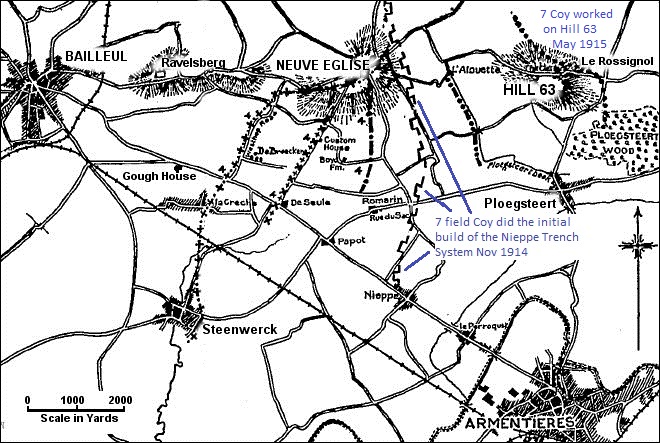
Photo courtesy IWM
Le Gheer front line trench:
This photo looking SE was taken 28 February 1915.
7 Field Company's first visit to Le Gheer was on 17 October 1914, when the Company worked through the night entrenching here in support of the 12 Bde whose advance eastwards halted at this point. On the 18th and 19th October the Company was again working here with sections also working on defences at Le Touquet.
Le Gheer front line trench:
This photo looking SE was taken 28 February 1915.
7 Field Company's first visit to Le Gheer was on 17 October 1914, when the Company worked through the night entrenching here in support of the 12 Bde whose advance eastwards halted at this point. On the 18th and 19th October the Company was again working here with sections also working on defences at Le Touquet.
Looking south towards Le Gheer from the south-east side of Ploegsteert Wood. The British front line trenches ran a few yards to the left of this road and parallel to it. 7 Coy were in support of the advancing troops when they took Le Gheer and surrounding areas
The 11th Inf Bde sector started at Le Gheer - Halte road exclusive and went north to Messines. 12th Inf Bde sector was from Le Gheer - Halte road inclusive south to the river Lys north of Houplines. 10 Inf Bde was south of the river Lys between Frelinghien and Houplines to Lille railway line south of Armentieres. At this time 7 Coy supported 12 Bde, 9 Coy supported 10 Bde and both Coys supported 11 Bde.
On the 20th - 21st October there was heavy fighting at St Yves, Le Gheer and Le Touquet with Le Gheer being captured for a brief spell, a counter attack regained lost ground and 150 German prisoners taken.
The 11th Inf Bde sector started at Le Gheer - Halte road exclusive and went north to Messines. 12th Inf Bde sector was from Le Gheer - Halte road inclusive south to the river Lys north of Houplines. 10 Inf Bde was south of the river Lys between Frelinghien and Houplines to Lille railway line south of Armentieres. At this time 7 Coy supported 12 Bde, 9 Coy supported 10 Bde and both Coys supported 11 Bde.
On the 20th - 21st October there was heavy fighting at St Yves, Le Gheer and Le Touquet with Le Gheer being captured for a brief spell, a counter attack regained lost ground and 150 German prisoners taken.
15 Nov. Work as before. Had breakfast at 7.30.am and paraded for work at 8.30.am. It is snowing hard and a gale blowing, came- ? Returning to supervise civilians and making of shelters until 4.30.pm
16 Nov. Some fitters and blacksmiths started working on steel loophole plates in Armentieres. The Sections worked on entrenchments and demolition of houses as before. Breakfast at 7.15.am and off to work at 8.30.am. It is raining hard and blowing a strong cold gale.
17 Nov. Major Symons, Lt Paterson (?) visited trenches of 12th Brigade to make arrangements for sappering as access to these trenches have become difficult owing to the approaches of German trenches within about 60 yards. Today is a bit better tho it is very cold and a bit showery, returned to billet at 4.30.pm.
18 Nov. No 3 Section and some fitters etc from other Sections started work on a girder bridge over the canal in Armentieres. Central span 65' with approaches: total span 122'. No1 Section was attached to 12th Brigade and worked in the trenches. No 2 and 4 Sections continued to work on back line areas. About 250 civilians were also employed each day. Breakfast at 7.30.am. It is a fine day, we made more shelters. Had a parcel of wool things from home. It is very cold.
19 Nov. No 3 worked for 12th Brigade most of Tuesday and at night, also putting up barbed wire. Other Sections worked as before. It is snowing hard, we could only work slowly, returned to billet at 4. pm.
20 Nov. Sections distributed as before. Lt G N Macready quitted the Company this day on appointment as the ADC to GOC 1st Division. Had breakfast at 7.15.am and at 8.30.am paraded for work - it has frozen hard during the night. A slight thaw set in during the morning, but after dinner it was frozen again. We returned to billet at 4.30.pm.
21 Nov. Lt Wright proceeded on 10 days leave to England. No 2 Section worked by day with the 9th Coy, in Ploegsteert woods. Again to work at 8.30 am still freezing. We returned to billet at 4.30.pm
22 Nov. No 1 still with 12th Brigade and billeted in Le Bizet. No 2 working with 9th Coy. No 3 on the bridge. No 4 on backline entrenchments with civilians. Paraded at 8am and went to Ploegsteert to make shelters in the woods. Plenty of spare bullets, we were back at billet by 5.pm
16 Nov. Some fitters and blacksmiths started working on steel loophole plates in Armentieres. The Sections worked on entrenchments and demolition of houses as before. Breakfast at 7.15.am and off to work at 8.30.am. It is raining hard and blowing a strong cold gale.
17 Nov. Major Symons, Lt Paterson (?) visited trenches of 12th Brigade to make arrangements for sappering as access to these trenches have become difficult owing to the approaches of German trenches within about 60 yards. Today is a bit better tho it is very cold and a bit showery, returned to billet at 4.30.pm.
18 Nov. No 3 Section and some fitters etc from other Sections started work on a girder bridge over the canal in Armentieres. Central span 65' with approaches: total span 122'. No1 Section was attached to 12th Brigade and worked in the trenches. No 2 and 4 Sections continued to work on back line areas. About 250 civilians were also employed each day. Breakfast at 7.30.am. It is a fine day, we made more shelters. Had a parcel of wool things from home. It is very cold.
19 Nov. No 3 worked for 12th Brigade most of Tuesday and at night, also putting up barbed wire. Other Sections worked as before. It is snowing hard, we could only work slowly, returned to billet at 4. pm.
20 Nov. Sections distributed as before. Lt G N Macready quitted the Company this day on appointment as the ADC to GOC 1st Division. Had breakfast at 7.15.am and at 8.30.am paraded for work - it has frozen hard during the night. A slight thaw set in during the morning, but after dinner it was frozen again. We returned to billet at 4.30.pm.
21 Nov. Lt Wright proceeded on 10 days leave to England. No 2 Section worked by day with the 9th Coy, in Ploegsteert woods. Again to work at 8.30 am still freezing. We returned to billet at 4.30.pm
22 Nov. No 1 still with 12th Brigade and billeted in Le Bizet. No 2 working with 9th Coy. No 3 on the bridge. No 4 on backline entrenchments with civilians. Paraded at 8am and went to Ploegsteert to make shelters in the woods. Plenty of spare bullets, we were back at billet by 5.pm
23 Nov. Work as before. During the night a heavy motor lorry (weight about 4 tons without its load of clothing) broke the pontoon bridge between Le Bizet and Armentieres. Again in the woods. A territorial and one of the 9th hit by spare bullets. We were back at billet as usual at 5.pm.
24 Nov. Work as before except that a barge, tackle etc were brought up to enable the lorry to be moved. A man of the Somerset's hit by a spare bullet. Five German snipers caught and shot.
25 Nov. Lorry was extracted and a new pontoon and Trestle bridge started during the day. This was worked on till 2am. Bridge as then complete but not satisfactory as the river bed had been much lowered and the approaches and Trestles were not satisfactory. Only a few men worked on the girder bridge this day. A month from Xmas and 12 months service in the Re's. Still working on the shelters, returned as usual at 5.pm.
26 Nov. New approaches were made for the pontoon bridge by No 4 Section and civilian labour. We finished the shelters at 2.30pm as it was too warm to continue for the Germans have begun to smell a rat. Two or three shells dropped only a dozen yards behind us. Our artillery had previously sent some 6 inch shells over.
24 Nov. Work as before except that a barge, tackle etc were brought up to enable the lorry to be moved. A man of the Somerset's hit by a spare bullet. Five German snipers caught and shot.
25 Nov. Lorry was extracted and a new pontoon and Trestle bridge started during the day. This was worked on till 2am. Bridge as then complete but not satisfactory as the river bed had been much lowered and the approaches and Trestles were not satisfactory. Only a few men worked on the girder bridge this day. A month from Xmas and 12 months service in the Re's. Still working on the shelters, returned as usual at 5.pm.
26 Nov. New approaches were made for the pontoon bridge by No 4 Section and civilian labour. We finished the shelters at 2.30pm as it was too warm to continue for the Germans have begun to smell a rat. Two or three shells dropped only a dozen yards behind us. Our artillery had previously sent some 6 inch shells over.
27 Nov. No1 was still with 12th Brigade. No 2 with 9th Field Co. No 3 on girder bridge. No 4 worked partly on ablution benches etc for troops in billets. Partly on girder bridge. It was much quieter today, we have nearly finished our share of shelters, only six men and N.C.O. to come up tomorrow.
28 Nov. Work continued as before. Horror of horrors, we have finished 6 of their shelters, the 9th have only done 5 of their share. Had no lunch today as I was with the terriers and Somerset's digging party. The 5th City of London are fed up, and only been out three weeks too. We arrived home at 5.pm.
29 Nov. Work continued as before. Three cyclists paraded at 7.45.am, of course I am one of them. We proceeded to the woods and reported to 9th Coy. Major. Bread and cheese composed our Sunday dinner. Two fellows wounded by spare bullets
30 Nov. Work continued as before. A note on Strength, Casualties etc for November is attached.
Paraded again at 7.45.am and proceeded as yesterday to the woods which are now very muddy. We left at 3.30.pm.
28 Nov. Work continued as before. Horror of horrors, we have finished 6 of their shelters, the 9th have only done 5 of their share. Had no lunch today as I was with the terriers and Somerset's digging party. The 5th City of London are fed up, and only been out three weeks too. We arrived home at 5.pm.
29 Nov. Work continued as before. Three cyclists paraded at 7.45.am, of course I am one of them. We proceeded to the woods and reported to 9th Coy. Major. Bread and cheese composed our Sunday dinner. Two fellows wounded by spare bullets
30 Nov. Work continued as before. A note on Strength, Casualties etc for November is attached.
Paraded again at 7.45.am and proceeded as yesterday to the woods which are now very muddy. We left at 3.30.pm.
Above: 7 Field Company would have been involved in the digging of this trench at Le Gheer
The ''Strand'' communication trench constructed by 7 Field Company 1914
December 1914
1 Dec. No1 Section working with 12 Brigade on shelters and barricades during the night. Nos 2,3 and 4 Sections on bridge and miscellaneous jobs till midday. In afternoon had hot baths at Divisional Baths. Lt Wright returned from 10 days leave. We do no work today as we are having a hot water bath and clean change this afternoon. The bath is a vat in a brewery by the riverside. Ten men in each vat and we were allowed 10 minutes to wash. This is my second bath I have had, the other was on the last day of the retreat, in a small stream running through an orchard.
1 Dec. No1 Section working with 12 Brigade on shelters and barricades during the night. Nos 2,3 and 4 Sections on bridge and miscellaneous jobs till midday. In afternoon had hot baths at Divisional Baths. Lt Wright returned from 10 days leave. We do no work today as we are having a hot water bath and clean change this afternoon. The bath is a vat in a brewery by the riverside. Ten men in each vat and we were allowed 10 minutes to wash. This is my second bath I have had, the other was on the last day of the retreat, in a small stream running through an orchard.
2 Dec. No1 working for 12th Brigade, No 2 for 11th Brigade in Ploegsteert wood, making shelters. No 3 and 4 working on bridge, ablution benches etc, till dinner. Then paraded at Nieppe for inspection by HM the King. Sergt Johnson receiving Distinguished Conduct Medal at the same time. Capt Smith proceeded on ten days leave. Work in the wood as usual, we left there at 2.30pm as we have at last finished. We were just in time to see the King and Prince of Wales as they passed thro' after inspecting those troops who were not on duty.
3 Dec. No 3 Section working on bridge. Nos 1, 2 and 3 worked for 12th Brigade, the last two on wire entanglements. Detachments also worked on pontoon bridge, cart repairs, trench mortars etc. I had a holiday today as it was impossible to go on any longer on this second pair of boots, which are not so good as the first pair. I had them repaired by one of our fellows at a modest price of one and a half Francs.
4 Dec. No1 Section making shelters for 12th Brigade. No 2 road making and pontoon drill. No 3 on girder bridge. No 4 making roads, trench mortars etc. Paraded at 8.30.am and rehearsed parts of the Wheldon trestle and method of launching from a raft. After dinner we practised knot tying. Had a letter from home.
5 Dec. No1 with 12th Brigade doing sandbag revetments. No 2 and 4 dismantling pontoon bridge and making mortars. No 3 on girder bridge. 2nd Lt Atkinson arrived and took over No 2 Section. It is raining hard today. We paraded at 9am. I took a message to the bridging train as we are taking up the pontoon bridge. We returned to billed at 4.30.pm.
6 Dec. No1 Section draining trenches, working pumps and making bombs. Nos 2, 3 and 4 completing bridge, making mortars and restoring pontoon equipment for 2nd Bridging Train. This morning we have our new officer. Mr Atkinson. We repair 3rd line which has collapsed in one or two places. There is a parade for C of E,s. I had to find the church.
7 Dec. No1 with 12th Brigade. No 2 doing drainage and shelters. No 3 at pontoon drill and painting the girder bridge. No 4 building kitchen and making mortars. We are again on the trenches, we had to bail out before we could work as there is over 2ft of water. We have dinner at 1.pm, finishing work at 4.pm.
8 Dec. No1 with 12th Brigade. No 2 on shelters and drainage. No 3 on painting, making trench mortars and drainage. No 4 on kitchen, shelters and gun. Today we are working in Ploegsteert Woods making a pathway to Somerset House. Our road is called 'The Strand'. We return to billet at 4.pm.
9 Dec. No1 with 12th Brigade. Nos 2 and 4 for Somerset L.I (11th Brig) at night in the trenches. No 3 on drainage, bridge etc. Continued working on the pathway, we had plenty os spare bullets again. It rained a little this afternoon.
10 Dec. No1 with 12th Brigade, draining trenches. Nos 2 and 4 in Ploegsteert Wood on roads and breastworks and some men at night in the trenches doing revetment. No 3 making gun, doing drainage and superintending infantry at woodwork. Still on the path, nothing of note has happened.
11 Dec. No 3 leveling aerodrome, doing drainage, making loophole plates and mortar. Other Sections as before. We have been felling timber today for shelters.
12 Dec. Sections distributed as before. More wood felling and then at night 13 of us went to Le Gheer making loopholes in the remains of some houses. One bullet hit a wall near me sending pieces in my face. We returned to billet at 2 am.
13 Dec. No1 with 12th Brigade. Nos 2 and 4 in Ploegsteert Wood by day making shelters and breastworks. Some of No 2 on entanglements etc at night. No 3 on Miscellaneous works as before. We prepare a few small pickets for use tonight. We continue with the loop holes and put up one or two sand bag walls also a trip wire. It is a beastly night, we got wet thro'. The Germans are very active with their flares. We arrive home at 1.45 pm.
14 Dec. Nos 2 and 4 working on plank roadways into Ploegsteert Wood. No 1 and 3 working as before. We have an easy day. I woke up very stiff and with a rotten headache, later we packed a pontoon and two trestle wagons.
15 - 22 Dec. No 2 and 4 worked daily except on the 19th when work was not possible owing to the regiments there employed on attacking the German Trenches. In Ploegsteert Wood , No1 Plank roadways, drains, breastworks etc. On several nights No 4 Section provided a Sappering party for infantry employed on drainage near Le Gheer. No 3 Section worked in wood yards near Armentieres,on roads,on drainage and levelling an aerodrome ground etc. No1 continued to be employed in the trenches with the 12th Brigade being billeted in Le Bizet. Today we make a path from the 'Rifle Brigade' HQ to the Essex Farm. We soon finish and arrive back at 3.30.pm.
16 Dec. This morning we have another path to make. It is called 'Spy Corner'. We came across a dead horse, which had been dead for ages. I am one of the unfortunate beggers told off to bury it. Our infantry working party had six injured by a shell which dropped on the Strand. The Germans have been fairly active with their guns.
17 Dec. We continue with the path in the woods. About 50 shells drop 200yds from us. We return to billet at 4 pm.
18 Dec. Mr Atkinson tossed up with Mr Wright for which section was to have a day in, we won so after a clean arms inspection we had the day off.
19 Dec. I am on guard today. This is the 3rd I have done since we have been sent out.
20 Dec. I was on fatiques during the morning fetching wood from Armetieres. Nothing to do during the afternoon.
21 Dec. I am not on day work as I shall be working tonight at a house which was captured by the 'Somerset's' last Saturday. we could not do much work so returned after putting up barbed wire. The Germans are in a house 50 yards away.
22 Dec. No work so had a day off, it is something to have an easy time!
23- 24 Dec. No 3 Section provided a party of 16 men to work on strengthening houses etc for defences at Le Gheer, working each night from 6.pm till 12.30.am. A small party of No 2 Section worked at night on other houses in front of Ploegsteert Wood. The remainder of the Company worked as before. Today we are working in the wood on the pathway again.
24 Dec. I am working tonight. The excitement in the trenches is great. Singing going on by friend and foe, each applauding the other. Great cheers when a flare goes up. All the noise is a great help to us, we put up some more wire in front of the house. There must be a dead German under the bricks by the smell. I found a helmet.
25 Dec. The whole of Xmas day was observed as a holiday. Xmas day! We have the day off. 10 o'clock we parade for Princess Mary's Present, and the King's Card, after which we are free. Have Xmas pudding for dinner and fried meat. In the afternoon the Company played the Clyde Co, at football, we won. At night we went to a concert given by the cyclists.
26 Dec. Lt Gourlay proceeded on leave. No 3 Section worked during the night at Le Gheer. No 2 and 4 worked in the woods and No1 Section worked with 12 Brigade. We work on the house at night, it is much different from last night, being quiet. It is freezing
27 - 30 Dec. Work as before. The weekly rest day, a general clean up. I wrote several letters.
28 Dec. We go to the woods and make two barbed wire gates, it is raining hard.
29 Dec. We continue with the path. The mud is horrible.
30 Dec. Again in the woods with the path.
31 Dec. Worked as before except that No 3 Section were employed on miscellaneous work during the day. We have come to the first line of breastworks with the path.
3 Dec. No 3 Section working on bridge. Nos 1, 2 and 3 worked for 12th Brigade, the last two on wire entanglements. Detachments also worked on pontoon bridge, cart repairs, trench mortars etc. I had a holiday today as it was impossible to go on any longer on this second pair of boots, which are not so good as the first pair. I had them repaired by one of our fellows at a modest price of one and a half Francs.
4 Dec. No1 Section making shelters for 12th Brigade. No 2 road making and pontoon drill. No 3 on girder bridge. No 4 making roads, trench mortars etc. Paraded at 8.30.am and rehearsed parts of the Wheldon trestle and method of launching from a raft. After dinner we practised knot tying. Had a letter from home.
5 Dec. No1 with 12th Brigade doing sandbag revetments. No 2 and 4 dismantling pontoon bridge and making mortars. No 3 on girder bridge. 2nd Lt Atkinson arrived and took over No 2 Section. It is raining hard today. We paraded at 9am. I took a message to the bridging train as we are taking up the pontoon bridge. We returned to billed at 4.30.pm.
6 Dec. No1 Section draining trenches, working pumps and making bombs. Nos 2, 3 and 4 completing bridge, making mortars and restoring pontoon equipment for 2nd Bridging Train. This morning we have our new officer. Mr Atkinson. We repair 3rd line which has collapsed in one or two places. There is a parade for C of E,s. I had to find the church.
7 Dec. No1 with 12th Brigade. No 2 doing drainage and shelters. No 3 at pontoon drill and painting the girder bridge. No 4 building kitchen and making mortars. We are again on the trenches, we had to bail out before we could work as there is over 2ft of water. We have dinner at 1.pm, finishing work at 4.pm.
8 Dec. No1 with 12th Brigade. No 2 on shelters and drainage. No 3 on painting, making trench mortars and drainage. No 4 on kitchen, shelters and gun. Today we are working in Ploegsteert Woods making a pathway to Somerset House. Our road is called 'The Strand'. We return to billet at 4.pm.
9 Dec. No1 with 12th Brigade. Nos 2 and 4 for Somerset L.I (11th Brig) at night in the trenches. No 3 on drainage, bridge etc. Continued working on the pathway, we had plenty os spare bullets again. It rained a little this afternoon.
10 Dec. No1 with 12th Brigade, draining trenches. Nos 2 and 4 in Ploegsteert Wood on roads and breastworks and some men at night in the trenches doing revetment. No 3 making gun, doing drainage and superintending infantry at woodwork. Still on the path, nothing of note has happened.
11 Dec. No 3 leveling aerodrome, doing drainage, making loophole plates and mortar. Other Sections as before. We have been felling timber today for shelters.
12 Dec. Sections distributed as before. More wood felling and then at night 13 of us went to Le Gheer making loopholes in the remains of some houses. One bullet hit a wall near me sending pieces in my face. We returned to billet at 2 am.
13 Dec. No1 with 12th Brigade. Nos 2 and 4 in Ploegsteert Wood by day making shelters and breastworks. Some of No 2 on entanglements etc at night. No 3 on Miscellaneous works as before. We prepare a few small pickets for use tonight. We continue with the loop holes and put up one or two sand bag walls also a trip wire. It is a beastly night, we got wet thro'. The Germans are very active with their flares. We arrive home at 1.45 pm.
14 Dec. Nos 2 and 4 working on plank roadways into Ploegsteert Wood. No 1 and 3 working as before. We have an easy day. I woke up very stiff and with a rotten headache, later we packed a pontoon and two trestle wagons.
15 - 22 Dec. No 2 and 4 worked daily except on the 19th when work was not possible owing to the regiments there employed on attacking the German Trenches. In Ploegsteert Wood , No1 Plank roadways, drains, breastworks etc. On several nights No 4 Section provided a Sappering party for infantry employed on drainage near Le Gheer. No 3 Section worked in wood yards near Armentieres,on roads,on drainage and levelling an aerodrome ground etc. No1 continued to be employed in the trenches with the 12th Brigade being billeted in Le Bizet. Today we make a path from the 'Rifle Brigade' HQ to the Essex Farm. We soon finish and arrive back at 3.30.pm.
16 Dec. This morning we have another path to make. It is called 'Spy Corner'. We came across a dead horse, which had been dead for ages. I am one of the unfortunate beggers told off to bury it. Our infantry working party had six injured by a shell which dropped on the Strand. The Germans have been fairly active with their guns.
17 Dec. We continue with the path in the woods. About 50 shells drop 200yds from us. We return to billet at 4 pm.
18 Dec. Mr Atkinson tossed up with Mr Wright for which section was to have a day in, we won so after a clean arms inspection we had the day off.
19 Dec. I am on guard today. This is the 3rd I have done since we have been sent out.
20 Dec. I was on fatiques during the morning fetching wood from Armetieres. Nothing to do during the afternoon.
21 Dec. I am not on day work as I shall be working tonight at a house which was captured by the 'Somerset's' last Saturday. we could not do much work so returned after putting up barbed wire. The Germans are in a house 50 yards away.
22 Dec. No work so had a day off, it is something to have an easy time!
23- 24 Dec. No 3 Section provided a party of 16 men to work on strengthening houses etc for defences at Le Gheer, working each night from 6.pm till 12.30.am. A small party of No 2 Section worked at night on other houses in front of Ploegsteert Wood. The remainder of the Company worked as before. Today we are working in the wood on the pathway again.
24 Dec. I am working tonight. The excitement in the trenches is great. Singing going on by friend and foe, each applauding the other. Great cheers when a flare goes up. All the noise is a great help to us, we put up some more wire in front of the house. There must be a dead German under the bricks by the smell. I found a helmet.
25 Dec. The whole of Xmas day was observed as a holiday. Xmas day! We have the day off. 10 o'clock we parade for Princess Mary's Present, and the King's Card, after which we are free. Have Xmas pudding for dinner and fried meat. In the afternoon the Company played the Clyde Co, at football, we won. At night we went to a concert given by the cyclists.
26 Dec. Lt Gourlay proceeded on leave. No 3 Section worked during the night at Le Gheer. No 2 and 4 worked in the woods and No1 Section worked with 12 Brigade. We work on the house at night, it is much different from last night, being quiet. It is freezing
27 - 30 Dec. Work as before. The weekly rest day, a general clean up. I wrote several letters.
28 Dec. We go to the woods and make two barbed wire gates, it is raining hard.
29 Dec. We continue with the path. The mud is horrible.
30 Dec. Again in the woods with the path.
31 Dec. Worked as before except that No 3 Section were employed on miscellaneous work during the day. We have come to the first line of breastworks with the path.
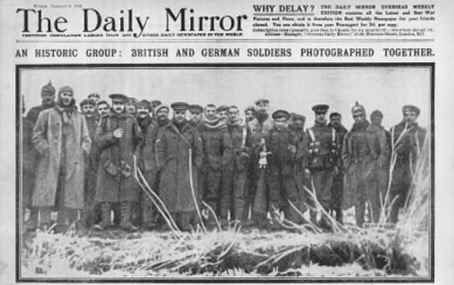
19 Oct. During the night 18-19th Nos 1 and 2 Sections built barricades etc, near Le Touquet village which the 12 Brigade were attacking during this and following days. No3 and 4 Sections marched across during the same night to Ploegsteert. In the morning of 19th, Company Headquarters moved to Le Bizet. Sections were again at work assisting the infantry (12th Brigade) to entrench on the 19th. Breakfast at 8 am and then sleep until dinner time. Had a parcel and a letter. We dug some trenches at night returning to bivouac at 2.am.
20 Oct. No 4 Section moved to Pont De Nieppe at midday and made a bridgehead on the right bank of the R, Lys. At night the 9th Co built a pontoon bridge between Le Bizet and Armentieres and No 4 Section made the approaches. No1 and 2 Sections worked on entrenchments during the night. Company headquarters and Nos 1 and 2 Sections moved to Ploegsteert at 6.pm. Nos 1, 2 and 3 Sections worked during the night at entrenchments etc.
N E of Bois De Ploegsteert. The last named Section assisting the 2nd Cavalry Brigade. I slept till dinner time after which I obtained a pair of socks and a new canteen. At 4.pm we had orders to stand to as the Germans were attacking where we were last night. We moved off at 5.pm to dig trenches for the Cavalry and then proceeded to our new billet in Ploegsteert arriving there at 2.am.
21 Oct. No 4 Section returned during the afternoon and marched near Messines where it built machine gun emplacements, returning during the night. Ploegeteert village was slightly shelled during the day. The Germans have captured the village at which we were last night taking about 50 Inniskillings. At 10.30.am we commence to put a wire entanglement in a wood. Here we learn that we have retaken Le Gheer, taking some 170 prisoners as well as relieving our own men. The prisoners were very pitiable looking objects, dirty, and unshaven and very glad to be taken. One of them said they only feared one of the allies and that was the English, he also declared that they were ordered to charge and when they were half way across their officers deserted them. They have lost 13,000 round here the last day or two. The English rifle fire is impossible to face. We finished work about 5.30.pm returning to a promised night in bed. There has been heavy shelling by both sides, particularly ours, there are several houses on fire.
20 Oct. No 4 Section moved to Pont De Nieppe at midday and made a bridgehead on the right bank of the R, Lys. At night the 9th Co built a pontoon bridge between Le Bizet and Armentieres and No 4 Section made the approaches. No1 and 2 Sections worked on entrenchments during the night. Company headquarters and Nos 1 and 2 Sections moved to Ploegsteert at 6.pm. Nos 1, 2 and 3 Sections worked during the night at entrenchments etc.
N E of Bois De Ploegsteert. The last named Section assisting the 2nd Cavalry Brigade. I slept till dinner time after which I obtained a pair of socks and a new canteen. At 4.pm we had orders to stand to as the Germans were attacking where we were last night. We moved off at 5.pm to dig trenches for the Cavalry and then proceeded to our new billet in Ploegsteert arriving there at 2.am.
21 Oct. No 4 Section returned during the afternoon and marched near Messines where it built machine gun emplacements, returning during the night. Ploegeteert village was slightly shelled during the day. The Germans have captured the village at which we were last night taking about 50 Inniskillings. At 10.30.am we commence to put a wire entanglement in a wood. Here we learn that we have retaken Le Gheer, taking some 170 prisoners as well as relieving our own men. The prisoners were very pitiable looking objects, dirty, and unshaven and very glad to be taken. One of them said they only feared one of the allies and that was the English, he also declared that they were ordered to charge and when they were half way across their officers deserted them. They have lost 13,000 round here the last day or two. The English rifle fire is impossible to face. We finished work about 5.30.pm returning to a promised night in bed. There has been heavy shelling by both sides, particularly ours, there are several houses on fire.
This track runs all the way down to
St Marguerite church.
Click on the thumbnail left to see position
of the trenches that crossed this track
St Marguerite church.
Click on the thumbnail left to see position
of the trenches that crossed this track
Photo courtesy the IWM
Photo courtesy the IWM
7 Field Company witnessed the Christmas Truce at St Yves - Ploegsteert Wood December 1914
The above photos taken of the new ''Khaki Chums'' memorial north of Ploegsteert Wood. The photo on the board is from an IWM photo and was taken in the 11th Inf Bde area. To get to the point where this photo was taken, the British soldiers would've had to cross the barbed wire 7 Field Company erected in no-man's land.
On Christmas eve 1914, Sections were working on trenches and defences east of Ploegsteert Wood and witnessed the Carol singing exchanges by both sides, which actually helped No 2 Section, as they were wiring the outside of a house only 50 yards away from the enemy.
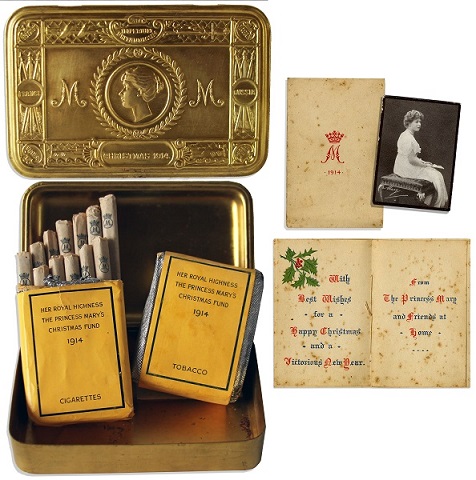
A Christmas Truce
The year is 1914 and World War 1 has been going on for 4 months,soldiers from Germany and Britain, living in mud filled trenches suffering from the cold weather, the chill of the icy rain pouring down on them, with the rain comes the constant shell bombardment from both sides,snipers picking off their targets death is everywhere hope is nowhere.
Suddenly around 10.pm after the guns had fallen silent,singing could be heard from the German trenches,
Stille Nacht! Heil'ge Nacht!
Alles schläft; einsam wacht
Nur das traute hoch heilige Paar.
Holder Knab' im lockigen Haar,
Schlafe in himmlischer Ruh!.
Christmas eve and the German soldiers were singing Carols,and after a while the British joined in singing in English, for the first time in four months there was hope in the air.
Day light came on Christmas morning, the soldiers from both trenches lay aside their arms got out of the trenches and walked into no man's land, about half way between the trenches, they shook hands and exchanged cigarettes and chocolate whilst wishing each other a merry Christmas,
a soccer ball was produced and both sides played soccer this went on for a while,slowly both sides dispersed back to their own respective trenches.
the next day the shelling started again and the war was back on. The miracle of peace and goodwill to all men never meant so much as it did on Christmas day 1914.
The year is 1914 and World War 1 has been going on for 4 months,soldiers from Germany and Britain, living in mud filled trenches suffering from the cold weather, the chill of the icy rain pouring down on them, with the rain comes the constant shell bombardment from both sides,snipers picking off their targets death is everywhere hope is nowhere.
Suddenly around 10.pm after the guns had fallen silent,singing could be heard from the German trenches,
Stille Nacht! Heil'ge Nacht!
Alles schläft; einsam wacht
Nur das traute hoch heilige Paar.
Holder Knab' im lockigen Haar,
Schlafe in himmlischer Ruh!.
Christmas eve and the German soldiers were singing Carols,and after a while the British joined in singing in English, for the first time in four months there was hope in the air.
Day light came on Christmas morning, the soldiers from both trenches lay aside their arms got out of the trenches and walked into no man's land, about half way between the trenches, they shook hands and exchanged cigarettes and chocolate whilst wishing each other a merry Christmas,
a soccer ball was produced and both sides played soccer this went on for a while,slowly both sides dispersed back to their own respective trenches.
the next day the shelling started again and the war was back on. The miracle of peace and goodwill to all men never meant so much as it did on Christmas day 1914.
On Christmas Day 1914 The Company paraded at 10 am for their
Princess Mary's Christmas gift and the King's Christmas Card, following which, they were then given the day off.
The Christmas gift box contained cigarettes and tobacco or chocolates for a non smoker. A small Christmas card was also enclosed. Everyone serving on the front-line were issued them, however, this gesture didn't extend beyond 1914.
Princess Mary's Christmas gift and the King's Christmas Card, following which, they were then given the day off.
The Christmas gift box contained cigarettes and tobacco or chocolates for a non smoker. A small Christmas card was also enclosed. Everyone serving on the front-line were issued them, however, this gesture didn't extend beyond 1914.
Princess Mary's Christmas gift box
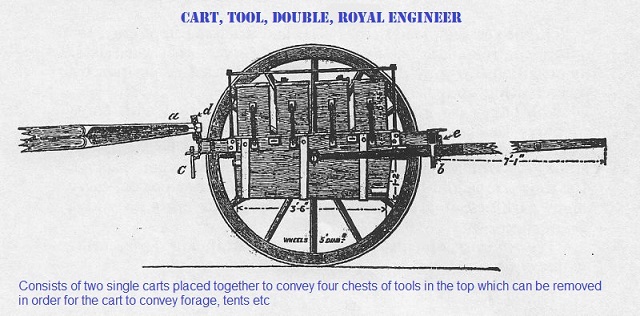
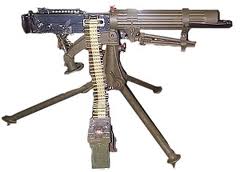
Vickers Gun
The .303 Vickers was large, belt-fed, water-cooled heavy machine gun used primarily in a static defensive role.
The .303 Vickers was large, belt-fed, water-cooled heavy machine gun used primarily in a static defensive role.
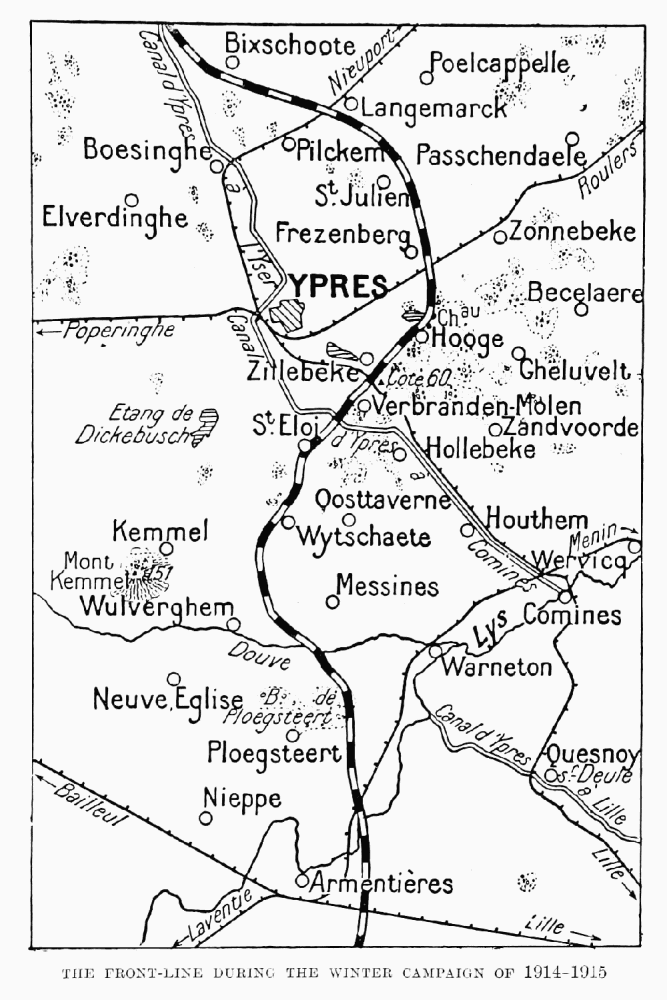
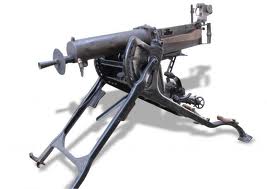
Maxim MG08
The MG08 was the first standard heavy machine gun used by the German Army during the First World War. The 08 refers to it's year of adoption, it remained in use until 1942, when it was replaced by the MG34 (1934)
The MG08 was the first standard heavy machine gun used by the German Army during the First World War. The 08 refers to it's year of adoption, it remained in use until 1942, when it was replaced by the MG34 (1934)
It is highly likely that 7 Field Company built the above second line breast-work trenches
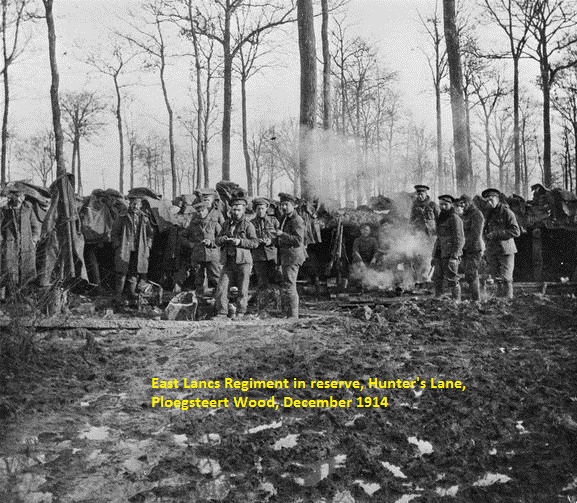
For a complete map of the Western Front 1914-1918 and more information on the battles that took place. Click on the link:
http://www.greatwar.co.uk/battles/#maubeugestquentin
http://www.bbc.co.uk/history/interactive/animations/western_front/index_embed.shtml
http://www.greatwar.co.uk/battles/#maubeugestquentin
http://www.bbc.co.uk/history/interactive/animations/western_front/index_embed.shtml

20189 Driver Hawkins. Arthur. R.I.P.
Driver Hawkins shares a grave with two others:
Pte J. R.P. Cockell - 3 Bn Worcester Regiment R.I.P.
Pte E.House D.C.M - 16th (queens) Lancers R.I.P.
They are buried at:
Bailleul Communal Cemetery Extension, Nord
Driver Hawkins shares a grave with two others:
Pte J. R.P. Cockell - 3 Bn Worcester Regiment R.I.P.
Pte E.House D.C.M - 16th (queens) Lancers R.I.P.
They are buried at:
Bailleul Communal Cemetery Extension, Nord
Saturday 3 Oct. The headquarters of the Company, less the bridging equipment and its personnel moved over into St Marguerite. No 1 Section moved from St Marguerite to Bucy Le Long. We have no work to do today or night for tomorrow we are going to Missy, which has been retaken from the enemy. We had some 'Jack Johnsons' over at tea time, too fine a range for our liking. Had a P.C. From Phil. (note: Phil being Jeffery's younger brother)
Sunday 4 Oct. Work as usual. We arrive at Missy at daybreak, a regular death trap, it has been shelled to pieces except one house where we are quartered. In the morning we made loop holes in the walls. There is generally one left to each house. We had to nip across the road pretty smart as there is plenty of sniping going on. Returned to St Marguerite 11.pm to see considerable damage to further end of the village, by shells.
5 Oct. Sections at work during the day. The whole Company quitted St Marguerite at 6.30pm and marched via pontoon bridge at Mouven Des Roches. ACY and ECURY to Rozieres, leaving No 4 Section at the bridge to dismantle it later. Company billeted in Chivry farm. We rose fairly late and had rifle and kit inspection, then plenty of shells over. We did nothing during the afternoon except drew new under clothes. Later we packed our kits. Our artillery is shelling the enemy heavily. Two days ago we received the very welcome 'Daily Mirror' blankets. At 6.pm we started on the track arriving at Rozieres at 10.30pm. What a relief to be out of those shells. "I don't know where we're going to but when we get the * ".
6 Oct. In the same billets. No 4 Section rejoined in the morning. Lt Stavert RESR left for base. We have nothing to do all day. I have sore feet owing to wearing my new boots. Had a game of draughts during the afternoon.
7 Oct. In billets all day marched at midnight. Breakfast at 7.30.am and clean arms, inspection at 9.am. We hear that the French have taken over St Marguerite. I have obtained No 14 bicycle. We commenced marching at 11.30.pm and kept on until 4.am. A pontoon got into the ditch so cyclists had to help it out.
Sunday 4 Oct. Work as usual. We arrive at Missy at daybreak, a regular death trap, it has been shelled to pieces except one house where we are quartered. In the morning we made loop holes in the walls. There is generally one left to each house. We had to nip across the road pretty smart as there is plenty of sniping going on. Returned to St Marguerite 11.pm to see considerable damage to further end of the village, by shells.
5 Oct. Sections at work during the day. The whole Company quitted St Marguerite at 6.30pm and marched via pontoon bridge at Mouven Des Roches. ACY and ECURY to Rozieres, leaving No 4 Section at the bridge to dismantle it later. Company billeted in Chivry farm. We rose fairly late and had rifle and kit inspection, then plenty of shells over. We did nothing during the afternoon except drew new under clothes. Later we packed our kits. Our artillery is shelling the enemy heavily. Two days ago we received the very welcome 'Daily Mirror' blankets. At 6.pm we started on the track arriving at Rozieres at 10.30pm. What a relief to be out of those shells. "I don't know where we're going to but when we get the * ".
6 Oct. In the same billets. No 4 Section rejoined in the morning. Lt Stavert RESR left for base. We have nothing to do all day. I have sore feet owing to wearing my new boots. Had a game of draughts during the afternoon.
7 Oct. In billets all day marched at midnight. Breakfast at 7.30.am and clean arms, inspection at 9.am. We hear that the French have taken over St Marguerite. I have obtained No 14 bicycle. We commenced marching at 11.30.pm and kept on until 4.am. A pontoon got into the ditch so cyclists had to help it out.
October 1914.
1 Oct. Company employed as before. Made more hurdles during the morning. After dinner we made a fire place in the shelter. I had a parcel and a letter. No work tonight so have a good sleep.
2 Oct. 2Lt Latham RE joined the Company from the Base and took command of No 1 Section from Lt Stavert. Work as usual. The 4th Division extended it's front line to the East taking over ground formerly occupied by the 5th Brigade (which was withdrawn) including the village of Missy . This change involved bringing some of our working parties within 200yds of the enemies trenches. How Dangerous! (penciled comment after the entry). We do no work during the day. At 8.pm we commence to make a large barricade where our trenches are enfiladed.we are hidden from the Germans by a large tarpaulin. We finish at 2.am
1 Oct. Company employed as before. Made more hurdles during the morning. After dinner we made a fire place in the shelter. I had a parcel and a letter. No work tonight so have a good sleep.
2 Oct. 2Lt Latham RE joined the Company from the Base and took command of No 1 Section from Lt Stavert. Work as usual. The 4th Division extended it's front line to the East taking over ground formerly occupied by the 5th Brigade (which was withdrawn) including the village of Missy . This change involved bringing some of our working parties within 200yds of the enemies trenches. How Dangerous! (penciled comment after the entry). We do no work during the day. At 8.pm we commence to make a large barricade where our trenches are enfiladed.we are hidden from the Germans by a large tarpaulin. We finish at 2.am
22 Oct. Sections collected barbed wire and posts during the day. No 1, 2 and 3 Sections worked at night. The firing continues. This morning we are collecting wire for entanglement. After dinner we cut the required pickets. Paraded at 5.pm and reached St Yves at 6.30.pm. It has been terribly shelled, not a house standing and huge holes in the ground. We had nearly completed one entanglement when our fellows in the trenches opened fire upon us. The enemy replied from 400yds. Down we flopped, after the first 2 or 3 minutes we began to get used to it, yet I could not help wondering where or when I should be hit. The bullets were ricocheting off the wire and plumping into the ground all around us. After twenty minutes, firing ceased, so waiting about five minutes we crept back to our own trenches with great care to let our fellows know who we were as it was quite possible that they would have fired on us. We were all very thankful to get out of what had been a tight corner.we arrived back at our billet at about 3.am.
The Company's first action of the war also saw their first casualties of the war:
10519 Spr Butler
11760 Spr Coleman
According to the war diary they were listed as missing believed to be dead, as they were wounded. However, there is no record of them in any CWGC cemeteries and therefore they could have been taken prisoner and survived.
10519 Spr Butler
11760 Spr Coleman
According to the war diary they were listed as missing believed to be dead, as they were wounded. However, there is no record of them in any CWGC cemeteries and therefore they could have been taken prisoner and survived.
Company strength as at 31 August 1914
Officers - 6
Other ranks - 211
Attached RAMC - 2
Horses - 76
Officers - 6
Other ranks - 211
Attached RAMC - 2
Horses - 76
Sections were billeted in this church school from 13 November 1914 to 13 February 1915
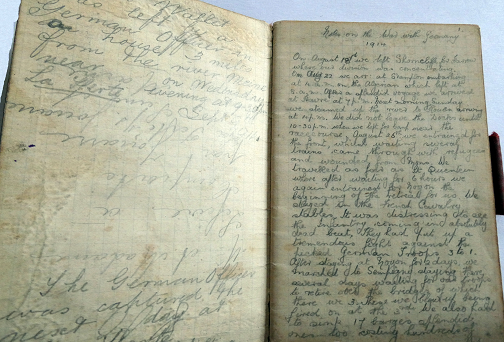
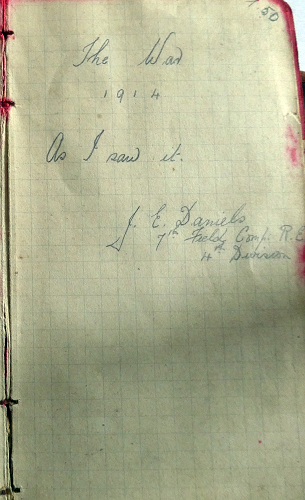
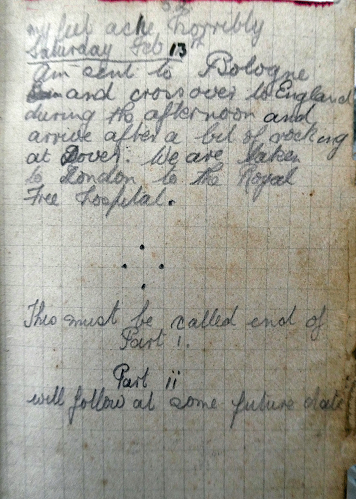
Photos of J.E. Daniels personal war diary (3) courtesy Carol Watt, Grandaughter of J.E. Daniels